Strategic Manufacturing Management of Singleton Electric Report
VerifiedAdded on 2022/09/01
|21
|5055
|20
Report
AI Summary
This report provides a comprehensive analysis of Singleton Electric, an Australian company specializing in industrial batteries for electric wheelchairs and golf carts. The report begins with a broad analysis of the company, including market dynamics using Porter's model and financial analysis of sales trends and costs. It then delves into Singleton's core competencies, such as its flexible production capacity and skilled workforce, and identifies potential new competencies needed for producing new battery technologies like lithium-ion batteries. The report also examines product selection, recommending the production of solid-state batteries and providing insights into market research, technology infusion, and customer feedback. The report concludes by analyzing the company's capacity strategy, including suggestions for capacity planning and its implications. The analysis incorporates concepts from units 1-6, including core competency and capacity strategy, to provide strategic recommendations for Singleton Electric.

Running head: MARKETING
Strategic manufacturing management of Singleton
Name of the student:
Name of the university:
Author note:
Strategic manufacturing management of Singleton
Name of the student:
Name of the university:
Author note:
Paraphrase This Document
Need a fresh take? Get an instant paraphrase of this document with our AI Paraphraser
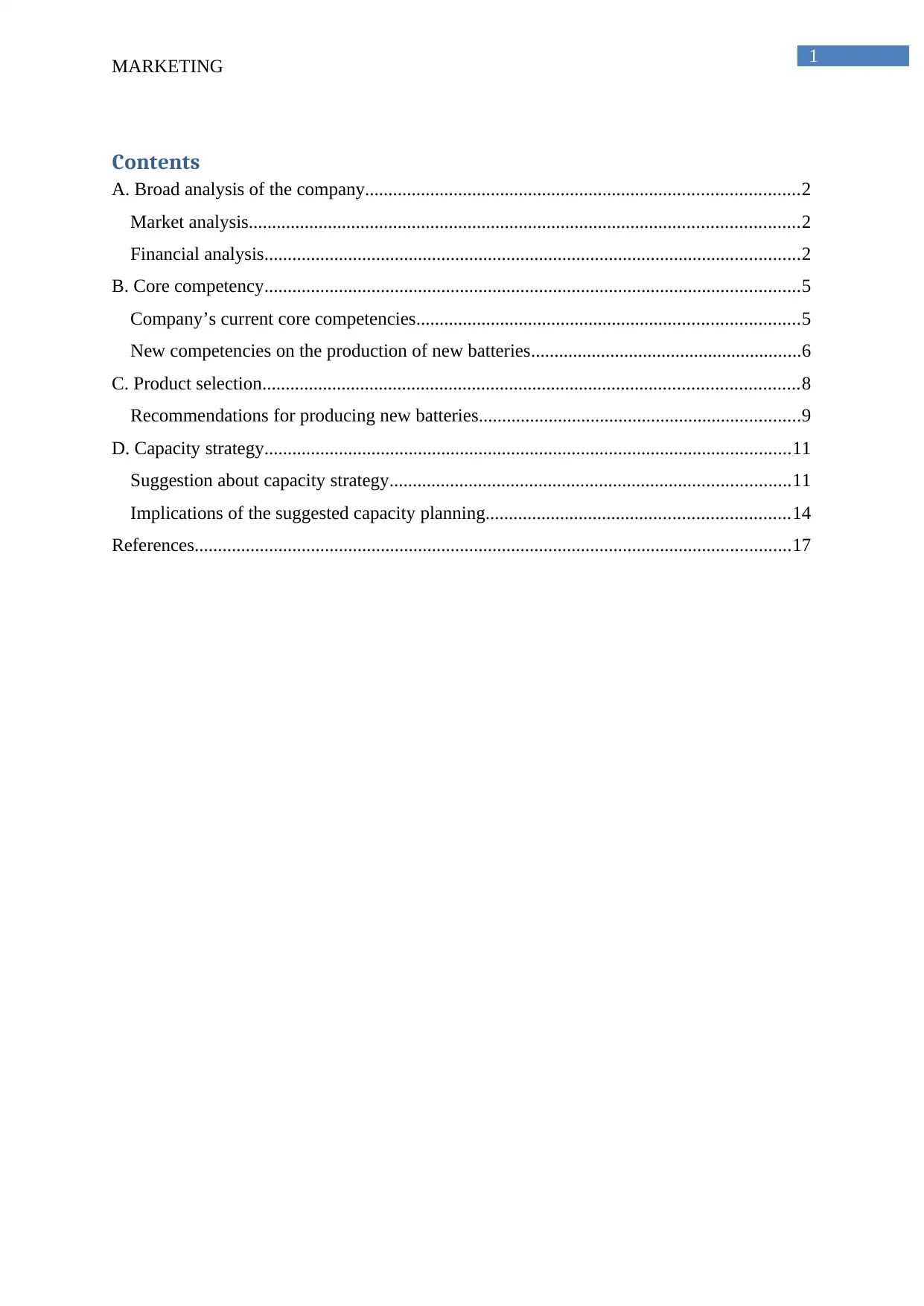
1
MARKETING
Contents
A. Broad analysis of the company.............................................................................................2
Market analysis......................................................................................................................2
Financial analysis...................................................................................................................2
B. Core competency...................................................................................................................5
Company’s current core competencies..................................................................................5
New competencies on the production of new batteries..........................................................6
C. Product selection...................................................................................................................8
Recommendations for producing new batteries.....................................................................9
D. Capacity strategy.................................................................................................................11
Suggestion about capacity strategy......................................................................................11
Implications of the suggested capacity planning.................................................................14
References................................................................................................................................17
MARKETING
Contents
A. Broad analysis of the company.............................................................................................2
Market analysis......................................................................................................................2
Financial analysis...................................................................................................................2
B. Core competency...................................................................................................................5
Company’s current core competencies..................................................................................5
New competencies on the production of new batteries..........................................................6
C. Product selection...................................................................................................................8
Recommendations for producing new batteries.....................................................................9
D. Capacity strategy.................................................................................................................11
Suggestion about capacity strategy......................................................................................11
Implications of the suggested capacity planning.................................................................14
References................................................................................................................................17
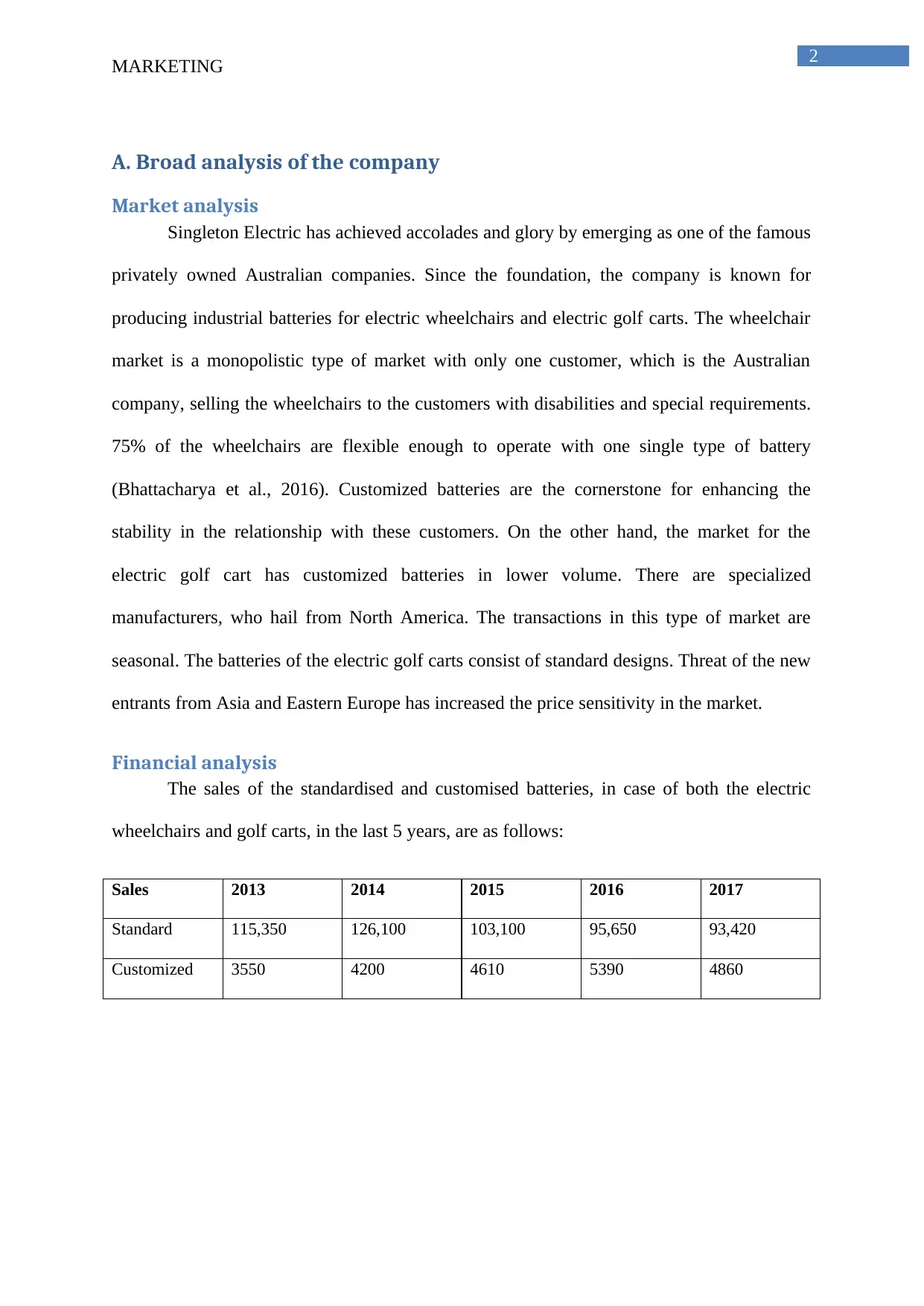
2
MARKETING
A. Broad analysis of the company
Market analysis
Singleton Electric has achieved accolades and glory by emerging as one of the famous
privately owned Australian companies. Since the foundation, the company is known for
producing industrial batteries for electric wheelchairs and electric golf carts. The wheelchair
market is a monopolistic type of market with only one customer, which is the Australian
company, selling the wheelchairs to the customers with disabilities and special requirements.
75% of the wheelchairs are flexible enough to operate with one single type of battery
(Bhattacharya et al., 2016). Customized batteries are the cornerstone for enhancing the
stability in the relationship with these customers. On the other hand, the market for the
electric golf cart has customized batteries in lower volume. There are specialized
manufacturers, who hail from North America. The transactions in this type of market are
seasonal. The batteries of the electric golf carts consist of standard designs. Threat of the new
entrants from Asia and Eastern Europe has increased the price sensitivity in the market.
Financial analysis
The sales of the standardised and customised batteries, in case of both the electric
wheelchairs and golf carts, in the last 5 years, are as follows:
Sales 2013 2014 2015 2016 2017
Standard 115,350 126,100 103,100 95,650 93,420
Customized 3550 4200 4610 5390 4860
MARKETING
A. Broad analysis of the company
Market analysis
Singleton Electric has achieved accolades and glory by emerging as one of the famous
privately owned Australian companies. Since the foundation, the company is known for
producing industrial batteries for electric wheelchairs and electric golf carts. The wheelchair
market is a monopolistic type of market with only one customer, which is the Australian
company, selling the wheelchairs to the customers with disabilities and special requirements.
75% of the wheelchairs are flexible enough to operate with one single type of battery
(Bhattacharya et al., 2016). Customized batteries are the cornerstone for enhancing the
stability in the relationship with these customers. On the other hand, the market for the
electric golf cart has customized batteries in lower volume. There are specialized
manufacturers, who hail from North America. The transactions in this type of market are
seasonal. The batteries of the electric golf carts consist of standard designs. Threat of the new
entrants from Asia and Eastern Europe has increased the price sensitivity in the market.
Financial analysis
The sales of the standardised and customised batteries, in case of both the electric
wheelchairs and golf carts, in the last 5 years, are as follows:
Sales 2013 2014 2015 2016 2017
Standard 115,350 126,100 103,100 95,650 93,420
Customized 3550 4200 4610 5390 4860
You're viewing a preview
Unlock full access by subscribing today!
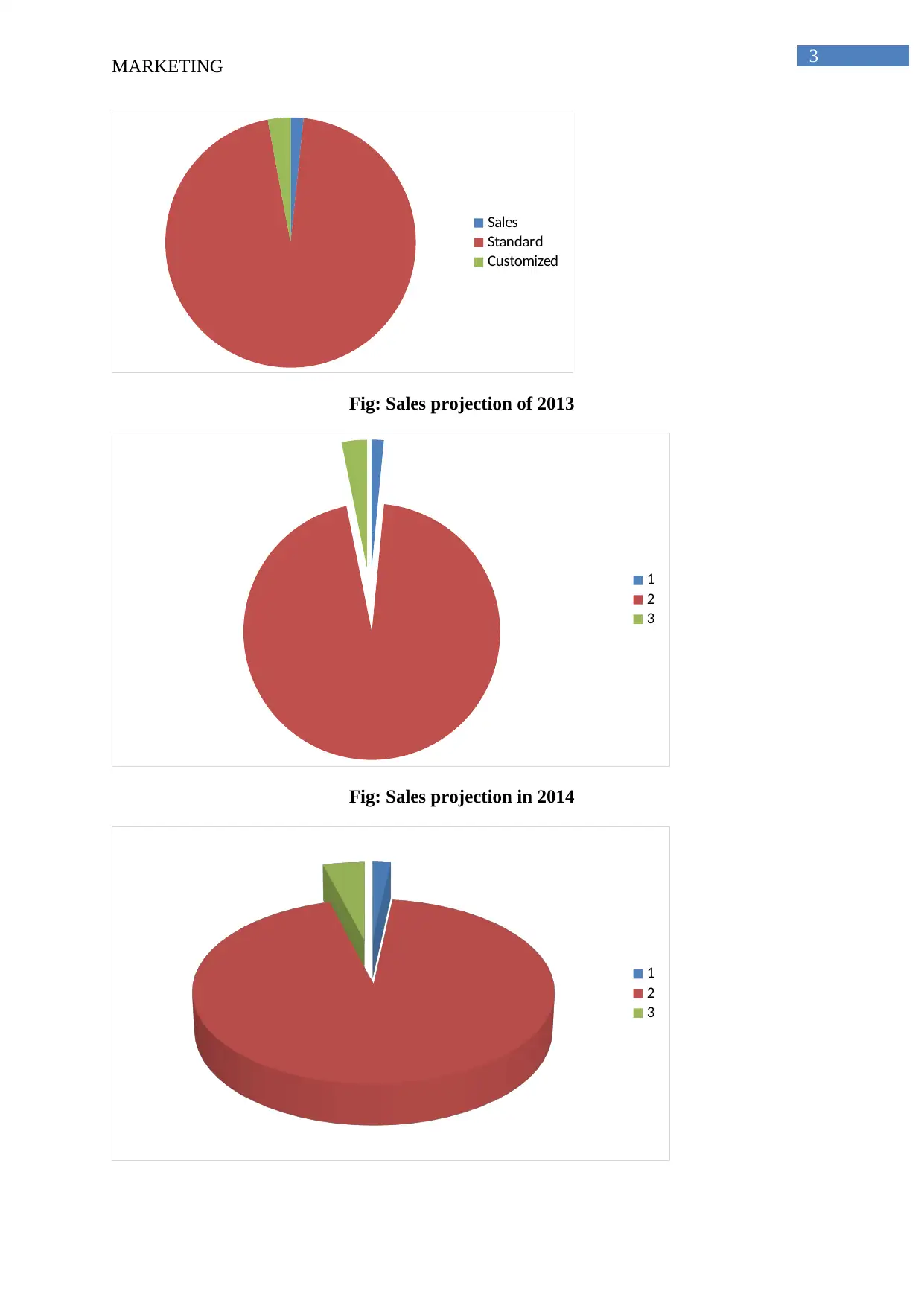
3
MARKETING
Sales
Standard
Customized
Fig: Sales projection of 2013
1
2
3
Fig: Sales projection in 2014
1
2
3
MARKETING
Sales
Standard
Customized
Fig: Sales projection of 2013
1
2
3
Fig: Sales projection in 2014
1
2
3
Paraphrase This Document
Need a fresh take? Get an instant paraphrase of this document with our AI Paraphraser
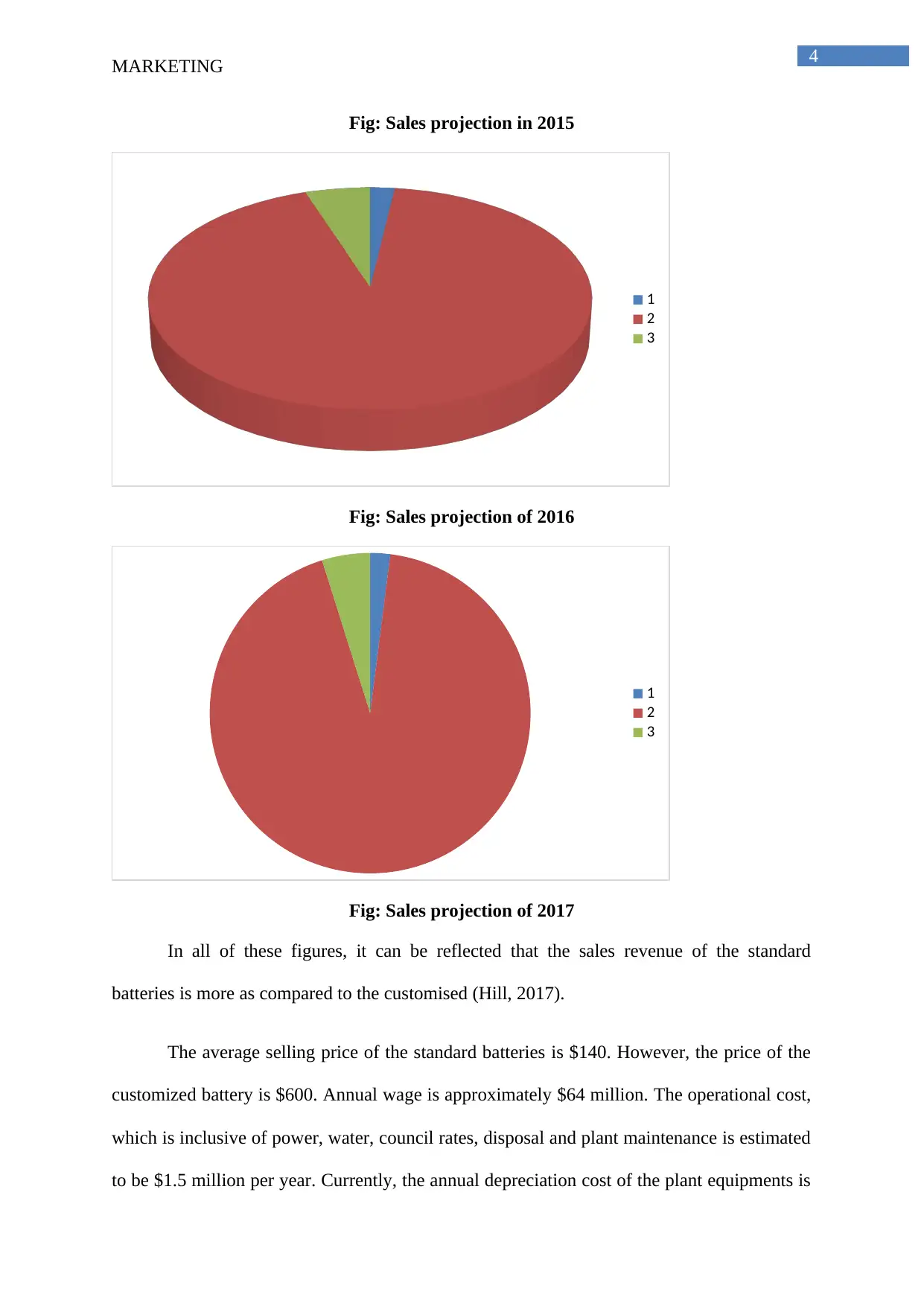
4
MARKETING
Fig: Sales projection in 2015
1
2
3
Fig: Sales projection of 2016
1
2
3
Fig: Sales projection of 2017
In all of these figures, it can be reflected that the sales revenue of the standard
batteries is more as compared to the customised (Hill, 2017).
The average selling price of the standard batteries is $140. However, the price of the
customized battery is $600. Annual wage is approximately $64 million. The operational cost,
which is inclusive of power, water, council rates, disposal and plant maintenance is estimated
to be $1.5 million per year. Currently, the annual depreciation cost of the plant equipments is
MARKETING
Fig: Sales projection in 2015
1
2
3
Fig: Sales projection of 2016
1
2
3
Fig: Sales projection of 2017
In all of these figures, it can be reflected that the sales revenue of the standard
batteries is more as compared to the customised (Hill, 2017).
The average selling price of the standard batteries is $140. However, the price of the
customized battery is $600. Annual wage is approximately $64 million. The operational cost,
which is inclusive of power, water, council rates, disposal and plant maintenance is estimated
to be $1.5 million per year. Currently, the annual depreciation cost of the plant equipments is
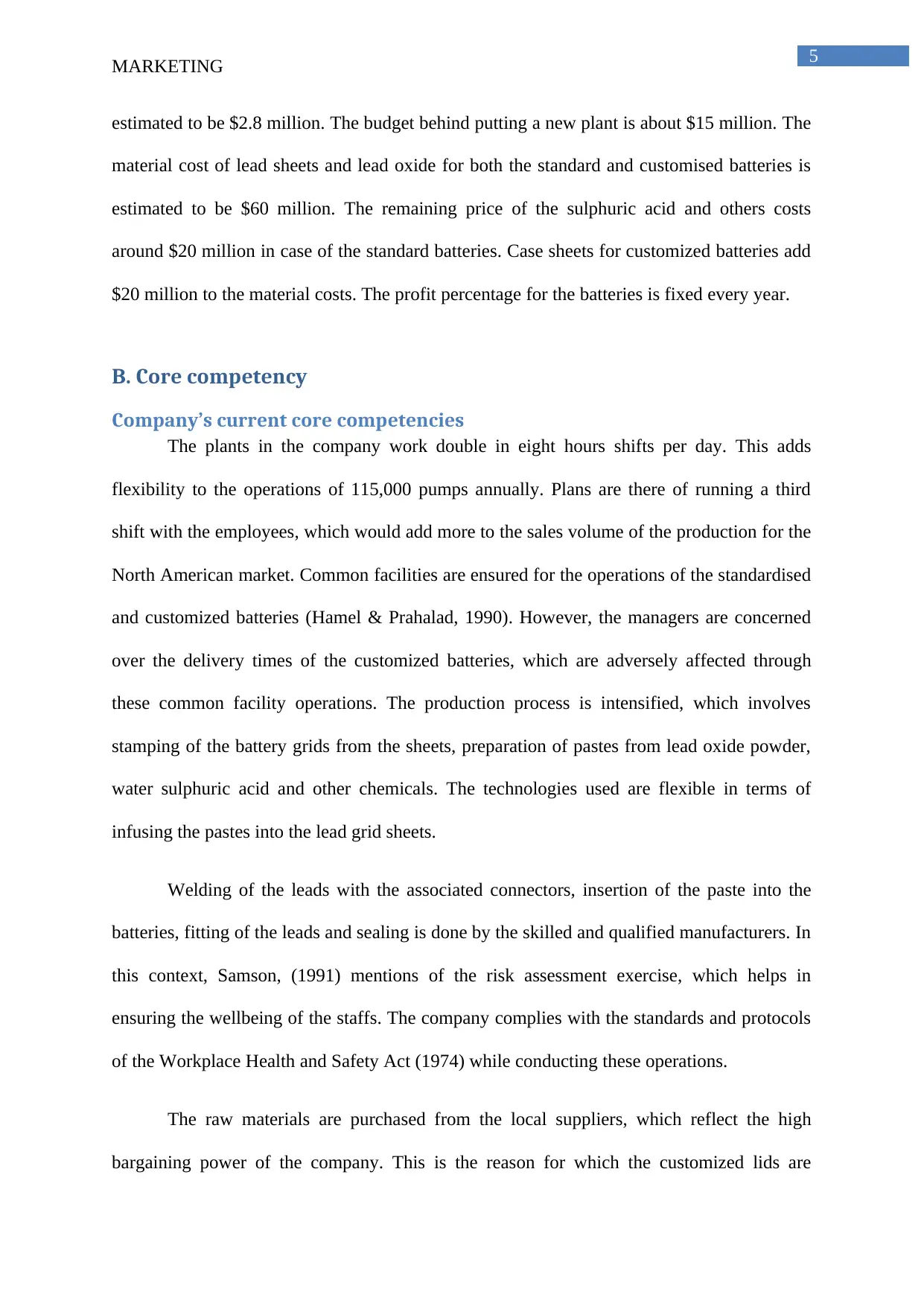
5
MARKETING
estimated to be $2.8 million. The budget behind putting a new plant is about $15 million. The
material cost of lead sheets and lead oxide for both the standard and customised batteries is
estimated to be $60 million. The remaining price of the sulphuric acid and others costs
around $20 million in case of the standard batteries. Case sheets for customized batteries add
$20 million to the material costs. The profit percentage for the batteries is fixed every year.
B. Core competency
Company’s current core competencies
The plants in the company work double in eight hours shifts per day. This adds
flexibility to the operations of 115,000 pumps annually. Plans are there of running a third
shift with the employees, which would add more to the sales volume of the production for the
North American market. Common facilities are ensured for the operations of the standardised
and customized batteries (Hamel & Prahalad, 1990). However, the managers are concerned
over the delivery times of the customized batteries, which are adversely affected through
these common facility operations. The production process is intensified, which involves
stamping of the battery grids from the sheets, preparation of pastes from lead oxide powder,
water sulphuric acid and other chemicals. The technologies used are flexible in terms of
infusing the pastes into the lead grid sheets.
Welding of the leads with the associated connectors, insertion of the paste into the
batteries, fitting of the leads and sealing is done by the skilled and qualified manufacturers. In
this context, Samson, (1991) mentions of the risk assessment exercise, which helps in
ensuring the wellbeing of the staffs. The company complies with the standards and protocols
of the Workplace Health and Safety Act (1974) while conducting these operations.
The raw materials are purchased from the local suppliers, which reflect the high
bargaining power of the company. This is the reason for which the customized lids are
MARKETING
estimated to be $2.8 million. The budget behind putting a new plant is about $15 million. The
material cost of lead sheets and lead oxide for both the standard and customised batteries is
estimated to be $60 million. The remaining price of the sulphuric acid and others costs
around $20 million in case of the standard batteries. Case sheets for customized batteries add
$20 million to the material costs. The profit percentage for the batteries is fixed every year.
B. Core competency
Company’s current core competencies
The plants in the company work double in eight hours shifts per day. This adds
flexibility to the operations of 115,000 pumps annually. Plans are there of running a third
shift with the employees, which would add more to the sales volume of the production for the
North American market. Common facilities are ensured for the operations of the standardised
and customized batteries (Hamel & Prahalad, 1990). However, the managers are concerned
over the delivery times of the customized batteries, which are adversely affected through
these common facility operations. The production process is intensified, which involves
stamping of the battery grids from the sheets, preparation of pastes from lead oxide powder,
water sulphuric acid and other chemicals. The technologies used are flexible in terms of
infusing the pastes into the lead grid sheets.
Welding of the leads with the associated connectors, insertion of the paste into the
batteries, fitting of the leads and sealing is done by the skilled and qualified manufacturers. In
this context, Samson, (1991) mentions of the risk assessment exercise, which helps in
ensuring the wellbeing of the staffs. The company complies with the standards and protocols
of the Workplace Health and Safety Act (1974) while conducting these operations.
The raw materials are purchased from the local suppliers, which reflect the high
bargaining power of the company. This is the reason for which the customized lids are
You're viewing a preview
Unlock full access by subscribing today!
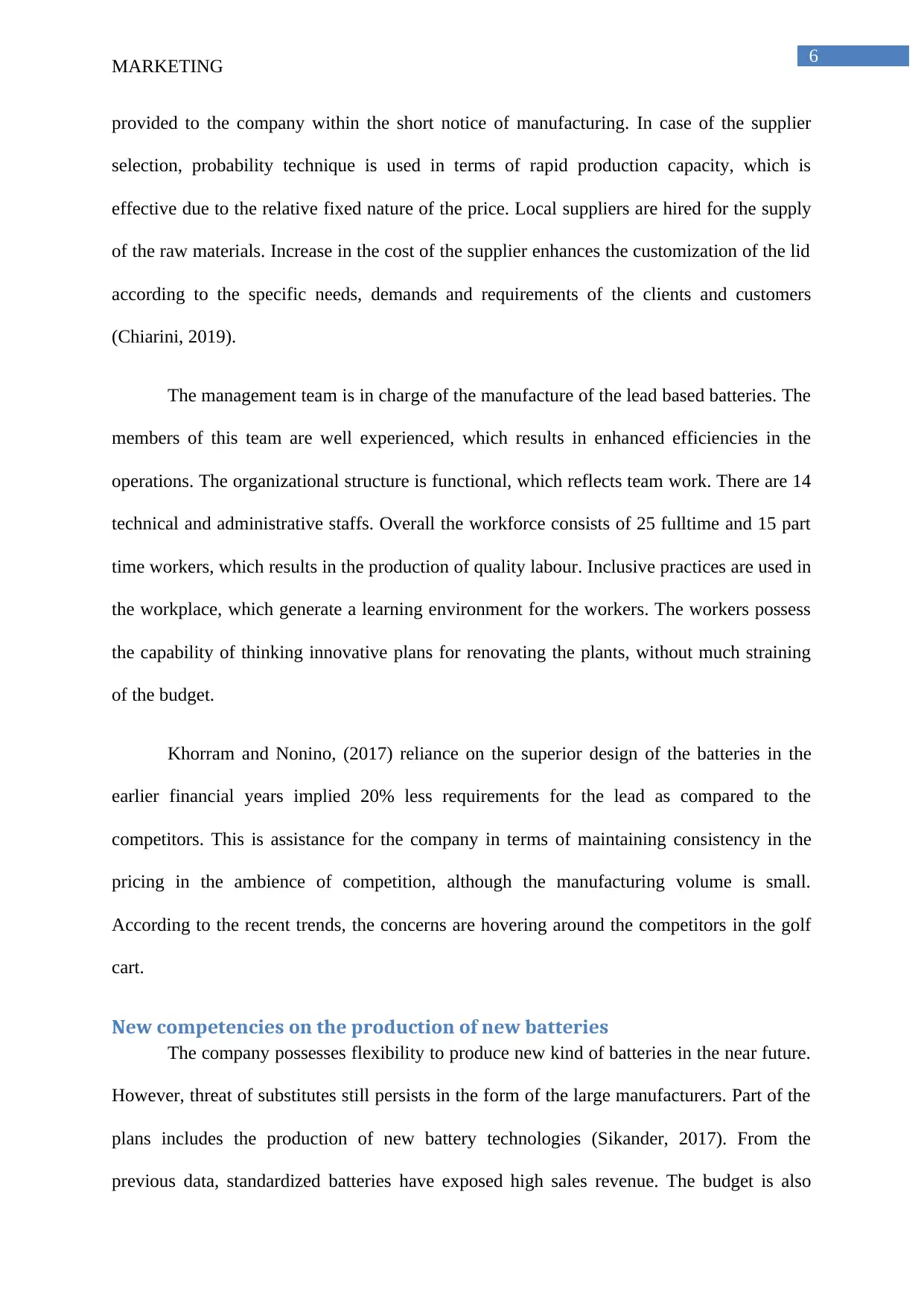
6
MARKETING
provided to the company within the short notice of manufacturing. In case of the supplier
selection, probability technique is used in terms of rapid production capacity, which is
effective due to the relative fixed nature of the price. Local suppliers are hired for the supply
of the raw materials. Increase in the cost of the supplier enhances the customization of the lid
according to the specific needs, demands and requirements of the clients and customers
(Chiarini, 2019).
The management team is in charge of the manufacture of the lead based batteries. The
members of this team are well experienced, which results in enhanced efficiencies in the
operations. The organizational structure is functional, which reflects team work. There are 14
technical and administrative staffs. Overall the workforce consists of 25 fulltime and 15 part
time workers, which results in the production of quality labour. Inclusive practices are used in
the workplace, which generate a learning environment for the workers. The workers possess
the capability of thinking innovative plans for renovating the plants, without much straining
of the budget.
Khorram and Nonino, (2017) reliance on the superior design of the batteries in the
earlier financial years implied 20% less requirements for the lead as compared to the
competitors. This is assistance for the company in terms of maintaining consistency in the
pricing in the ambience of competition, although the manufacturing volume is small.
According to the recent trends, the concerns are hovering around the competitors in the golf
cart.
New competencies on the production of new batteries
The company possesses flexibility to produce new kind of batteries in the near future.
However, threat of substitutes still persists in the form of the large manufacturers. Part of the
plans includes the production of new battery technologies (Sikander, 2017). From the
previous data, standardized batteries have exposed high sales revenue. The budget is also
MARKETING
provided to the company within the short notice of manufacturing. In case of the supplier
selection, probability technique is used in terms of rapid production capacity, which is
effective due to the relative fixed nature of the price. Local suppliers are hired for the supply
of the raw materials. Increase in the cost of the supplier enhances the customization of the lid
according to the specific needs, demands and requirements of the clients and customers
(Chiarini, 2019).
The management team is in charge of the manufacture of the lead based batteries. The
members of this team are well experienced, which results in enhanced efficiencies in the
operations. The organizational structure is functional, which reflects team work. There are 14
technical and administrative staffs. Overall the workforce consists of 25 fulltime and 15 part
time workers, which results in the production of quality labour. Inclusive practices are used in
the workplace, which generate a learning environment for the workers. The workers possess
the capability of thinking innovative plans for renovating the plants, without much straining
of the budget.
Khorram and Nonino, (2017) reliance on the superior design of the batteries in the
earlier financial years implied 20% less requirements for the lead as compared to the
competitors. This is assistance for the company in terms of maintaining consistency in the
pricing in the ambience of competition, although the manufacturing volume is small.
According to the recent trends, the concerns are hovering around the competitors in the golf
cart.
New competencies on the production of new batteries
The company possesses flexibility to produce new kind of batteries in the near future.
However, threat of substitutes still persists in the form of the large manufacturers. Part of the
plans includes the production of new battery technologies (Sikander, 2017). From the
previous data, standardized batteries have exposed high sales revenue. The budget is also
Paraphrase This Document
Need a fresh take? Get an instant paraphrase of this document with our AI Paraphraser
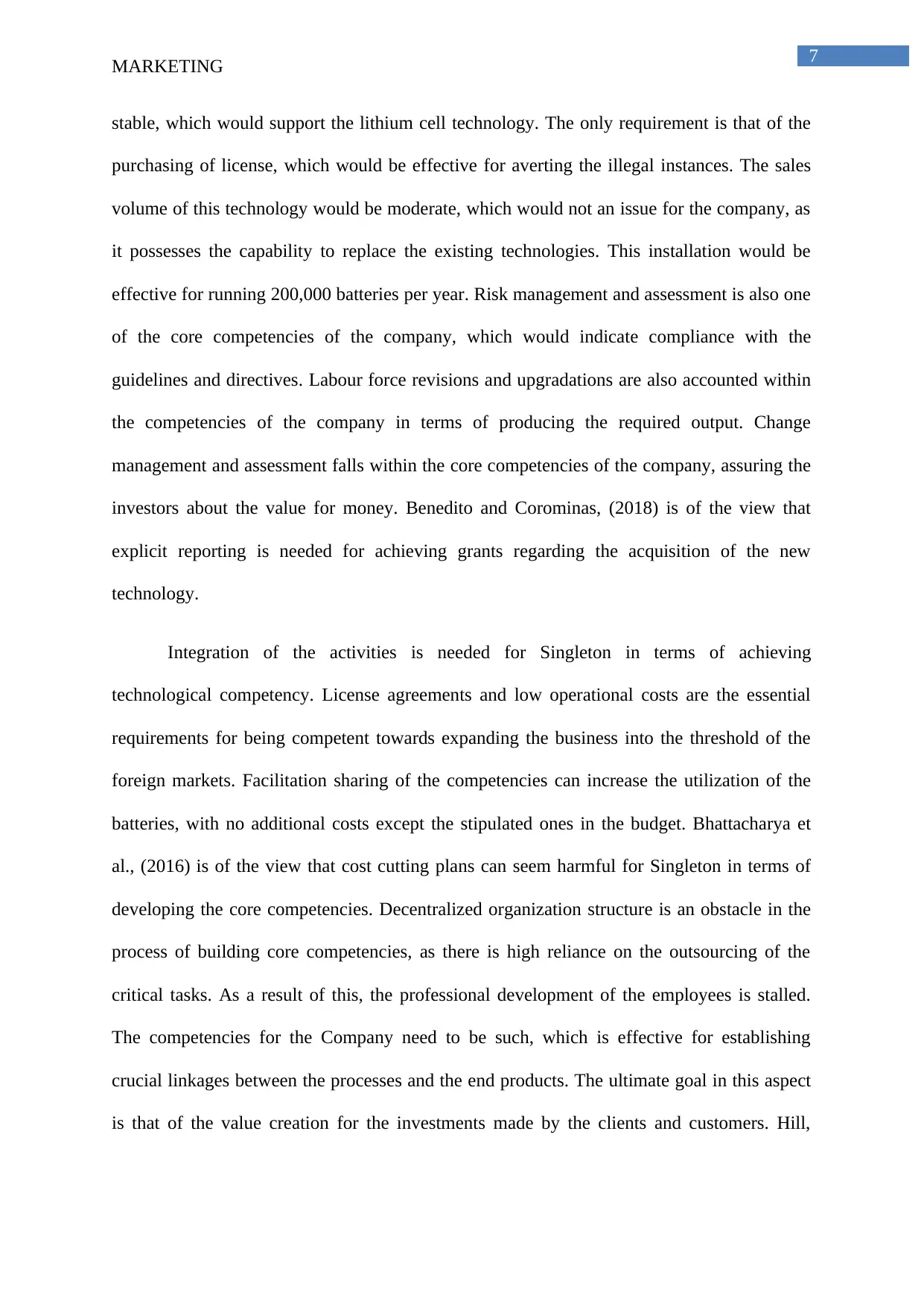
7
MARKETING
stable, which would support the lithium cell technology. The only requirement is that of the
purchasing of license, which would be effective for averting the illegal instances. The sales
volume of this technology would be moderate, which would not an issue for the company, as
it possesses the capability to replace the existing technologies. This installation would be
effective for running 200,000 batteries per year. Risk management and assessment is also one
of the core competencies of the company, which would indicate compliance with the
guidelines and directives. Labour force revisions and upgradations are also accounted within
the competencies of the company in terms of producing the required output. Change
management and assessment falls within the core competencies of the company, assuring the
investors about the value for money. Benedito and Corominas, (2018) is of the view that
explicit reporting is needed for achieving grants regarding the acquisition of the new
technology.
Integration of the activities is needed for Singleton in terms of achieving
technological competency. License agreements and low operational costs are the essential
requirements for being competent towards expanding the business into the threshold of the
foreign markets. Facilitation sharing of the competencies can increase the utilization of the
batteries, with no additional costs except the stipulated ones in the budget. Bhattacharya et
al., (2016) is of the view that cost cutting plans can seem harmful for Singleton in terms of
developing the core competencies. Decentralized organization structure is an obstacle in the
process of building core competencies, as there is high reliance on the outsourcing of the
critical tasks. As a result of this, the professional development of the employees is stalled.
The competencies for the Company need to be such, which is effective for establishing
crucial linkages between the processes and the end products. The ultimate goal in this aspect
is that of the value creation for the investments made by the clients and customers. Hill,
MARKETING
stable, which would support the lithium cell technology. The only requirement is that of the
purchasing of license, which would be effective for averting the illegal instances. The sales
volume of this technology would be moderate, which would not an issue for the company, as
it possesses the capability to replace the existing technologies. This installation would be
effective for running 200,000 batteries per year. Risk management and assessment is also one
of the core competencies of the company, which would indicate compliance with the
guidelines and directives. Labour force revisions and upgradations are also accounted within
the competencies of the company in terms of producing the required output. Change
management and assessment falls within the core competencies of the company, assuring the
investors about the value for money. Benedito and Corominas, (2018) is of the view that
explicit reporting is needed for achieving grants regarding the acquisition of the new
technology.
Integration of the activities is needed for Singleton in terms of achieving
technological competency. License agreements and low operational costs are the essential
requirements for being competent towards expanding the business into the threshold of the
foreign markets. Facilitation sharing of the competencies can increase the utilization of the
batteries, with no additional costs except the stipulated ones in the budget. Bhattacharya et
al., (2016) is of the view that cost cutting plans can seem harmful for Singleton in terms of
developing the core competencies. Decentralized organization structure is an obstacle in the
process of building core competencies, as there is high reliance on the outsourcing of the
critical tasks. As a result of this, the professional development of the employees is stalled.
The competencies for the Company need to be such, which is effective for establishing
crucial linkages between the processes and the end products. The ultimate goal in this aspect
is that of the value creation for the investments made by the clients and customers. Hill,
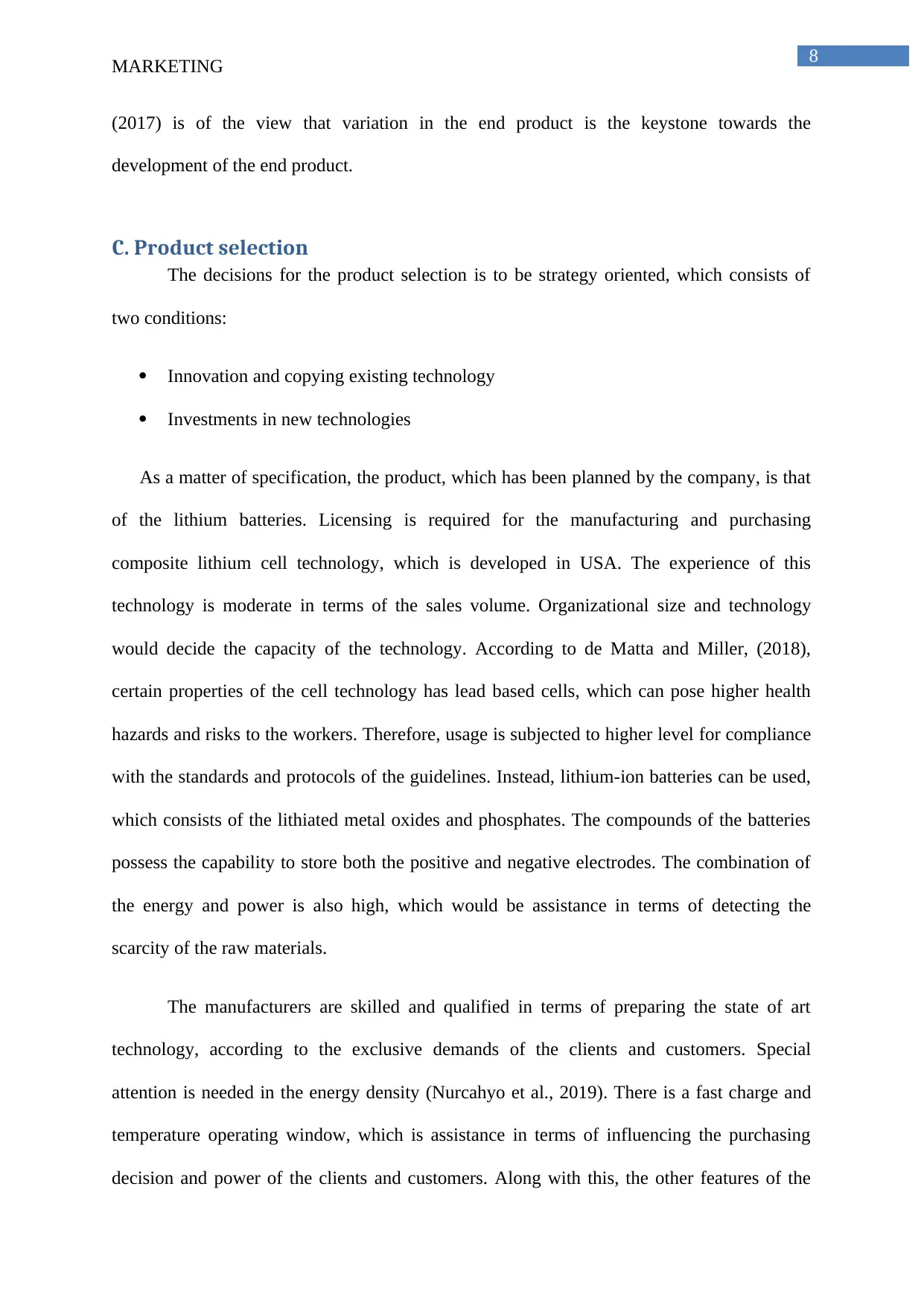
8
MARKETING
(2017) is of the view that variation in the end product is the keystone towards the
development of the end product.
C. Product selection
The decisions for the product selection is to be strategy oriented, which consists of
two conditions:
Innovation and copying existing technology
Investments in new technologies
As a matter of specification, the product, which has been planned by the company, is that
of the lithium batteries. Licensing is required for the manufacturing and purchasing
composite lithium cell technology, which is developed in USA. The experience of this
technology is moderate in terms of the sales volume. Organizational size and technology
would decide the capacity of the technology. According to de Matta and Miller, (2018),
certain properties of the cell technology has lead based cells, which can pose higher health
hazards and risks to the workers. Therefore, usage is subjected to higher level for compliance
with the standards and protocols of the guidelines. Instead, lithium-ion batteries can be used,
which consists of the lithiated metal oxides and phosphates. The compounds of the batteries
possess the capability to store both the positive and negative electrodes. The combination of
the energy and power is also high, which would be assistance in terms of detecting the
scarcity of the raw materials.
The manufacturers are skilled and qualified in terms of preparing the state of art
technology, according to the exclusive demands of the clients and customers. Special
attention is needed in the energy density (Nurcahyo et al., 2019). There is a fast charge and
temperature operating window, which is assistance in terms of influencing the purchasing
decision and power of the clients and customers. Along with this, the other features of the
MARKETING
(2017) is of the view that variation in the end product is the keystone towards the
development of the end product.
C. Product selection
The decisions for the product selection is to be strategy oriented, which consists of
two conditions:
Innovation and copying existing technology
Investments in new technologies
As a matter of specification, the product, which has been planned by the company, is that
of the lithium batteries. Licensing is required for the manufacturing and purchasing
composite lithium cell technology, which is developed in USA. The experience of this
technology is moderate in terms of the sales volume. Organizational size and technology
would decide the capacity of the technology. According to de Matta and Miller, (2018),
certain properties of the cell technology has lead based cells, which can pose higher health
hazards and risks to the workers. Therefore, usage is subjected to higher level for compliance
with the standards and protocols of the guidelines. Instead, lithium-ion batteries can be used,
which consists of the lithiated metal oxides and phosphates. The compounds of the batteries
possess the capability to store both the positive and negative electrodes. The combination of
the energy and power is also high, which would be assistance in terms of detecting the
scarcity of the raw materials.
The manufacturers are skilled and qualified in terms of preparing the state of art
technology, according to the exclusive demands of the clients and customers. Special
attention is needed in the energy density (Nurcahyo et al., 2019). There is a fast charge and
temperature operating window, which is assistance in terms of influencing the purchasing
decision and power of the clients and customers. Along with this, the other features of the
You're viewing a preview
Unlock full access by subscribing today!
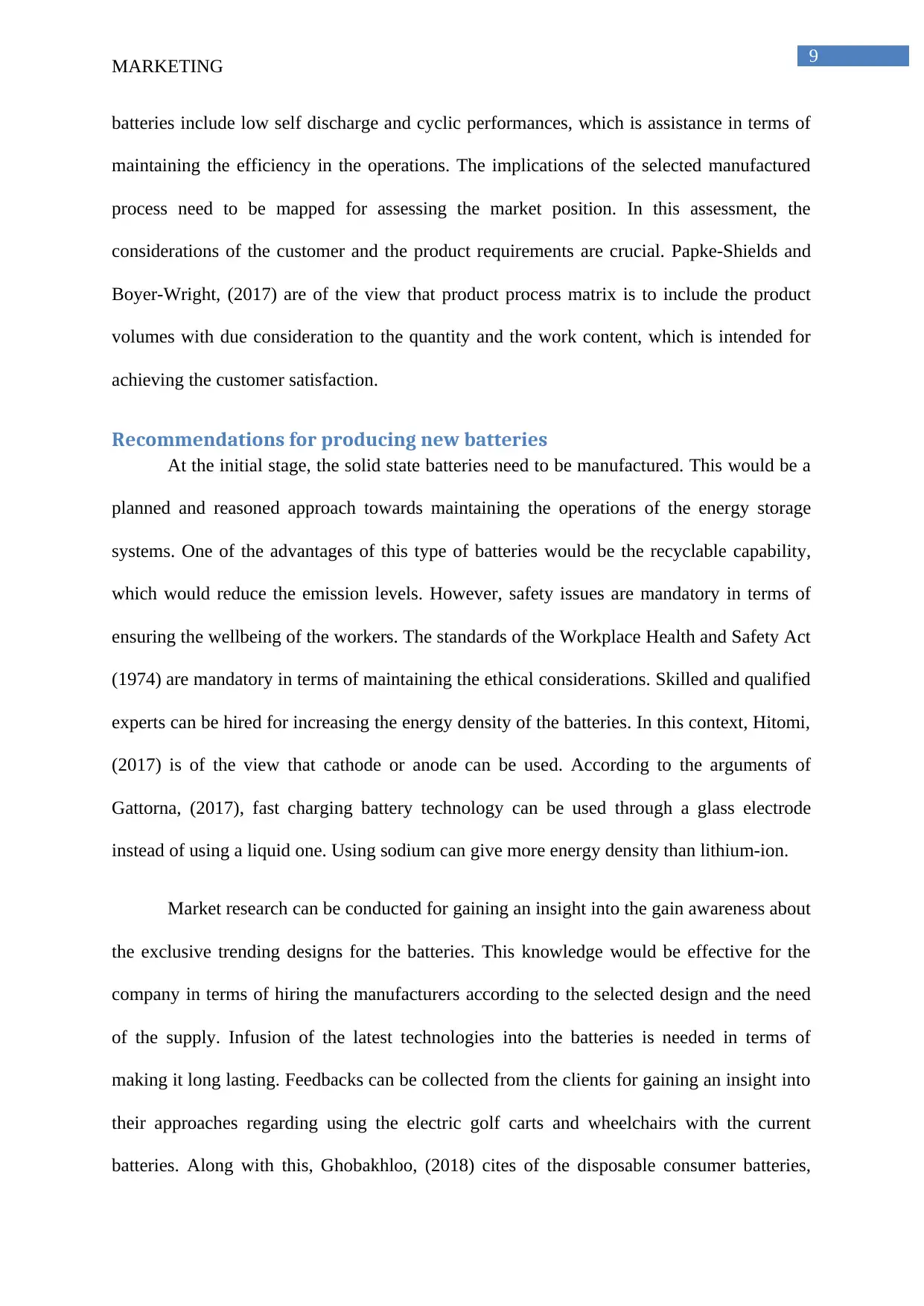
9
MARKETING
batteries include low self discharge and cyclic performances, which is assistance in terms of
maintaining the efficiency in the operations. The implications of the selected manufactured
process need to be mapped for assessing the market position. In this assessment, the
considerations of the customer and the product requirements are crucial. Papke-Shields and
Boyer-Wright, (2017) are of the view that product process matrix is to include the product
volumes with due consideration to the quantity and the work content, which is intended for
achieving the customer satisfaction.
Recommendations for producing new batteries
At the initial stage, the solid state batteries need to be manufactured. This would be a
planned and reasoned approach towards maintaining the operations of the energy storage
systems. One of the advantages of this type of batteries would be the recyclable capability,
which would reduce the emission levels. However, safety issues are mandatory in terms of
ensuring the wellbeing of the workers. The standards of the Workplace Health and Safety Act
(1974) are mandatory in terms of maintaining the ethical considerations. Skilled and qualified
experts can be hired for increasing the energy density of the batteries. In this context, Hitomi,
(2017) is of the view that cathode or anode can be used. According to the arguments of
Gattorna, (2017), fast charging battery technology can be used through a glass electrode
instead of using a liquid one. Using sodium can give more energy density than lithium-ion.
Market research can be conducted for gaining an insight into the gain awareness about
the exclusive trending designs for the batteries. This knowledge would be effective for the
company in terms of hiring the manufacturers according to the selected design and the need
of the supply. Infusion of the latest technologies into the batteries is needed in terms of
making it long lasting. Feedbacks can be collected from the clients for gaining an insight into
their approaches regarding using the electric golf carts and wheelchairs with the current
batteries. Along with this, Ghobakhloo, (2018) cites of the disposable consumer batteries,
MARKETING
batteries include low self discharge and cyclic performances, which is assistance in terms of
maintaining the efficiency in the operations. The implications of the selected manufactured
process need to be mapped for assessing the market position. In this assessment, the
considerations of the customer and the product requirements are crucial. Papke-Shields and
Boyer-Wright, (2017) are of the view that product process matrix is to include the product
volumes with due consideration to the quantity and the work content, which is intended for
achieving the customer satisfaction.
Recommendations for producing new batteries
At the initial stage, the solid state batteries need to be manufactured. This would be a
planned and reasoned approach towards maintaining the operations of the energy storage
systems. One of the advantages of this type of batteries would be the recyclable capability,
which would reduce the emission levels. However, safety issues are mandatory in terms of
ensuring the wellbeing of the workers. The standards of the Workplace Health and Safety Act
(1974) are mandatory in terms of maintaining the ethical considerations. Skilled and qualified
experts can be hired for increasing the energy density of the batteries. In this context, Hitomi,
(2017) is of the view that cathode or anode can be used. According to the arguments of
Gattorna, (2017), fast charging battery technology can be used through a glass electrode
instead of using a liquid one. Using sodium can give more energy density than lithium-ion.
Market research can be conducted for gaining an insight into the gain awareness about
the exclusive trending designs for the batteries. This knowledge would be effective for the
company in terms of hiring the manufacturers according to the selected design and the need
of the supply. Infusion of the latest technologies into the batteries is needed in terms of
making it long lasting. Feedbacks can be collected from the clients for gaining an insight into
their approaches regarding using the electric golf carts and wheelchairs with the current
batteries. Along with this, Ghobakhloo, (2018) cites of the disposable consumer batteries,
Paraphrase This Document
Need a fresh take? Get an instant paraphrase of this document with our AI Paraphraser
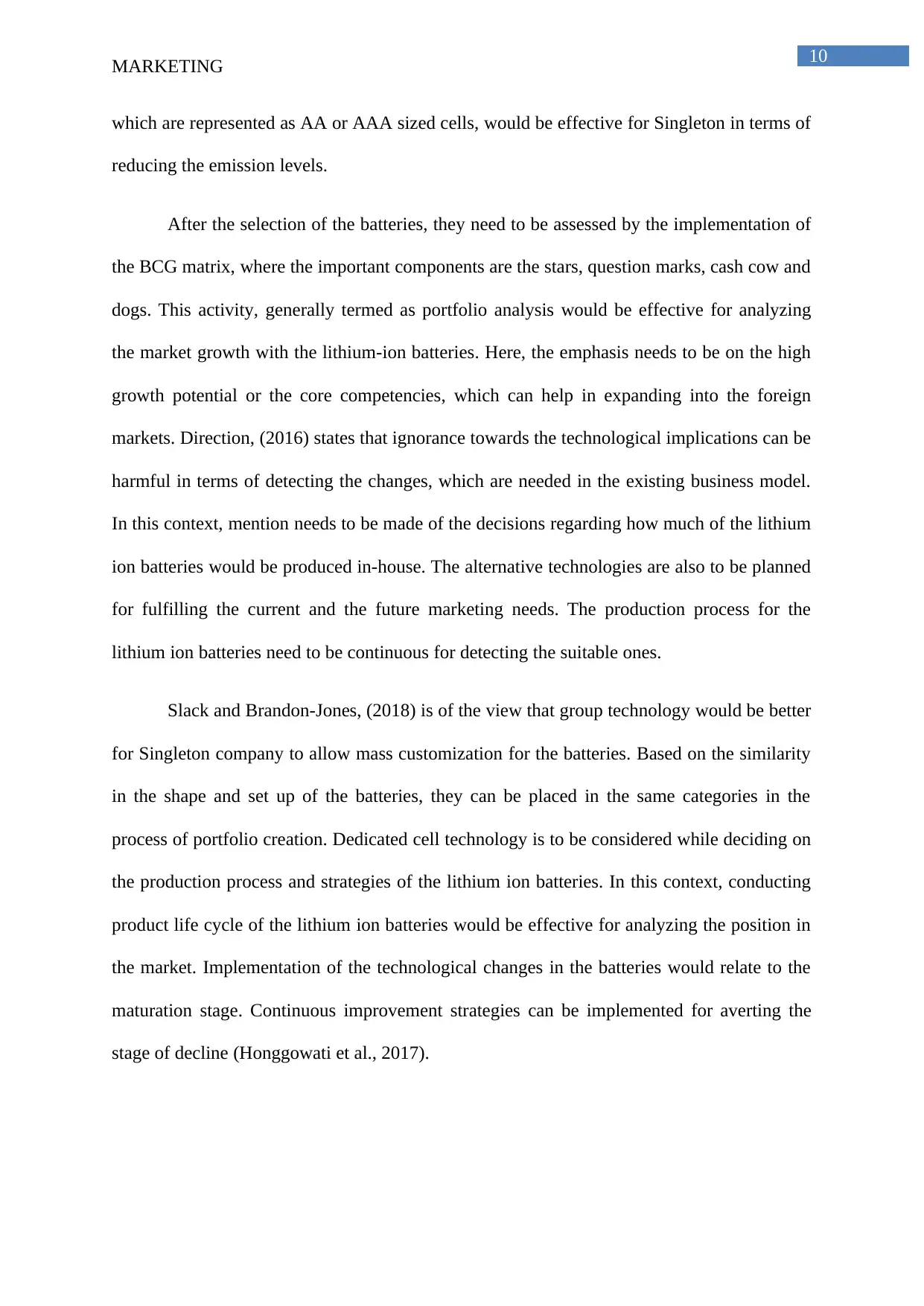
10
MARKETING
which are represented as AA or AAA sized cells, would be effective for Singleton in terms of
reducing the emission levels.
After the selection of the batteries, they need to be assessed by the implementation of
the BCG matrix, where the important components are the stars, question marks, cash cow and
dogs. This activity, generally termed as portfolio analysis would be effective for analyzing
the market growth with the lithium-ion batteries. Here, the emphasis needs to be on the high
growth potential or the core competencies, which can help in expanding into the foreign
markets. Direction, (2016) states that ignorance towards the technological implications can be
harmful in terms of detecting the changes, which are needed in the existing business model.
In this context, mention needs to be made of the decisions regarding how much of the lithium
ion batteries would be produced in-house. The alternative technologies are also to be planned
for fulfilling the current and the future marketing needs. The production process for the
lithium ion batteries need to be continuous for detecting the suitable ones.
Slack and Brandon-Jones, (2018) is of the view that group technology would be better
for Singleton company to allow mass customization for the batteries. Based on the similarity
in the shape and set up of the batteries, they can be placed in the same categories in the
process of portfolio creation. Dedicated cell technology is to be considered while deciding on
the production process and strategies of the lithium ion batteries. In this context, conducting
product life cycle of the lithium ion batteries would be effective for analyzing the position in
the market. Implementation of the technological changes in the batteries would relate to the
maturation stage. Continuous improvement strategies can be implemented for averting the
stage of decline (Honggowati et al., 2017).
MARKETING
which are represented as AA or AAA sized cells, would be effective for Singleton in terms of
reducing the emission levels.
After the selection of the batteries, they need to be assessed by the implementation of
the BCG matrix, where the important components are the stars, question marks, cash cow and
dogs. This activity, generally termed as portfolio analysis would be effective for analyzing
the market growth with the lithium-ion batteries. Here, the emphasis needs to be on the high
growth potential or the core competencies, which can help in expanding into the foreign
markets. Direction, (2016) states that ignorance towards the technological implications can be
harmful in terms of detecting the changes, which are needed in the existing business model.
In this context, mention needs to be made of the decisions regarding how much of the lithium
ion batteries would be produced in-house. The alternative technologies are also to be planned
for fulfilling the current and the future marketing needs. The production process for the
lithium ion batteries need to be continuous for detecting the suitable ones.
Slack and Brandon-Jones, (2018) is of the view that group technology would be better
for Singleton company to allow mass customization for the batteries. Based on the similarity
in the shape and set up of the batteries, they can be placed in the same categories in the
process of portfolio creation. Dedicated cell technology is to be considered while deciding on
the production process and strategies of the lithium ion batteries. In this context, conducting
product life cycle of the lithium ion batteries would be effective for analyzing the position in
the market. Implementation of the technological changes in the batteries would relate to the
maturation stage. Continuous improvement strategies can be implemented for averting the
stage of decline (Honggowati et al., 2017).
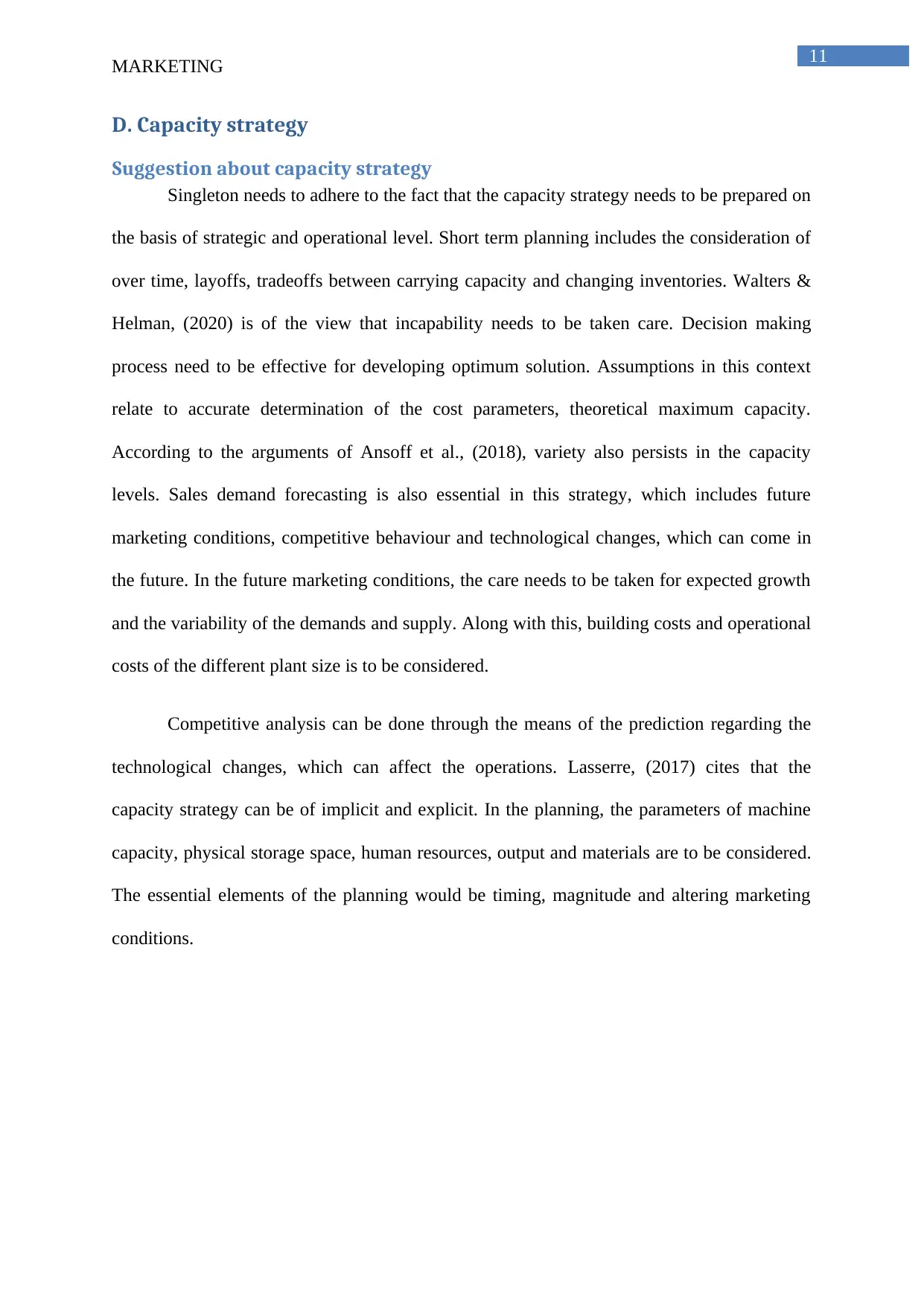
11
MARKETING
D. Capacity strategy
Suggestion about capacity strategy
Singleton needs to adhere to the fact that the capacity strategy needs to be prepared on
the basis of strategic and operational level. Short term planning includes the consideration of
over time, layoffs, tradeoffs between carrying capacity and changing inventories. Walters &
Helman, (2020) is of the view that incapability needs to be taken care. Decision making
process need to be effective for developing optimum solution. Assumptions in this context
relate to accurate determination of the cost parameters, theoretical maximum capacity.
According to the arguments of Ansoff et al., (2018), variety also persists in the capacity
levels. Sales demand forecasting is also essential in this strategy, which includes future
marketing conditions, competitive behaviour and technological changes, which can come in
the future. In the future marketing conditions, the care needs to be taken for expected growth
and the variability of the demands and supply. Along with this, building costs and operational
costs of the different plant size is to be considered.
Competitive analysis can be done through the means of the prediction regarding the
technological changes, which can affect the operations. Lasserre, (2017) cites that the
capacity strategy can be of implicit and explicit. In the planning, the parameters of machine
capacity, physical storage space, human resources, output and materials are to be considered.
The essential elements of the planning would be timing, magnitude and altering marketing
conditions.
MARKETING
D. Capacity strategy
Suggestion about capacity strategy
Singleton needs to adhere to the fact that the capacity strategy needs to be prepared on
the basis of strategic and operational level. Short term planning includes the consideration of
over time, layoffs, tradeoffs between carrying capacity and changing inventories. Walters &
Helman, (2020) is of the view that incapability needs to be taken care. Decision making
process need to be effective for developing optimum solution. Assumptions in this context
relate to accurate determination of the cost parameters, theoretical maximum capacity.
According to the arguments of Ansoff et al., (2018), variety also persists in the capacity
levels. Sales demand forecasting is also essential in this strategy, which includes future
marketing conditions, competitive behaviour and technological changes, which can come in
the future. In the future marketing conditions, the care needs to be taken for expected growth
and the variability of the demands and supply. Along with this, building costs and operational
costs of the different plant size is to be considered.
Competitive analysis can be done through the means of the prediction regarding the
technological changes, which can affect the operations. Lasserre, (2017) cites that the
capacity strategy can be of implicit and explicit. In the planning, the parameters of machine
capacity, physical storage space, human resources, output and materials are to be considered.
The essential elements of the planning would be timing, magnitude and altering marketing
conditions.
You're viewing a preview
Unlock full access by subscribing today!
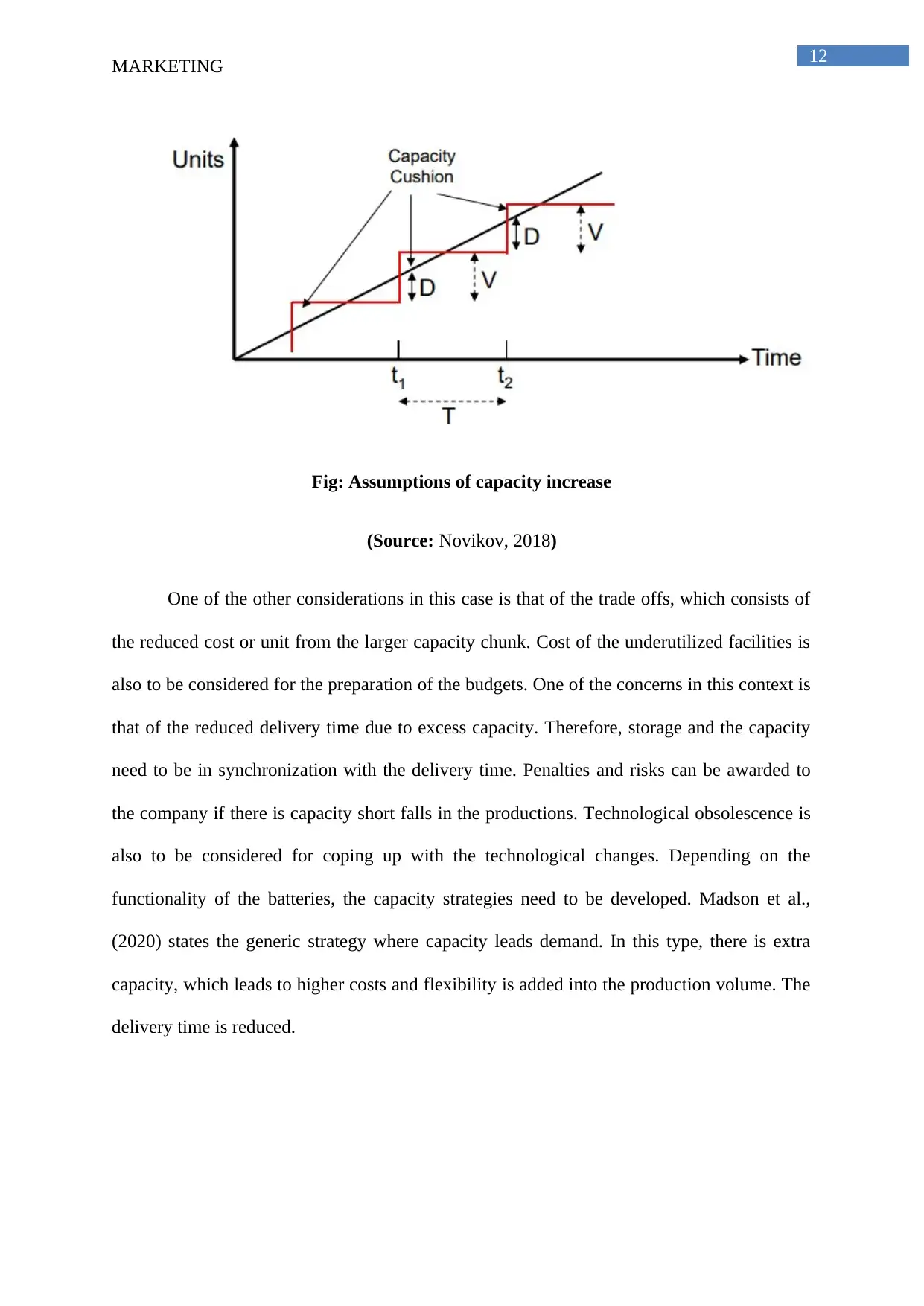
12
MARKETING
Fig: Assumptions of capacity increase
(Source: Novikov, 2018)
One of the other considerations in this case is that of the trade offs, which consists of
the reduced cost or unit from the larger capacity chunk. Cost of the underutilized facilities is
also to be considered for the preparation of the budgets. One of the concerns in this context is
that of the reduced delivery time due to excess capacity. Therefore, storage and the capacity
need to be in synchronization with the delivery time. Penalties and risks can be awarded to
the company if there is capacity short falls in the productions. Technological obsolescence is
also to be considered for coping up with the technological changes. Depending on the
functionality of the batteries, the capacity strategies need to be developed. Madson et al.,
(2020) states the generic strategy where capacity leads demand. In this type, there is extra
capacity, which leads to higher costs and flexibility is added into the production volume. The
delivery time is reduced.
MARKETING
Fig: Assumptions of capacity increase
(Source: Novikov, 2018)
One of the other considerations in this case is that of the trade offs, which consists of
the reduced cost or unit from the larger capacity chunk. Cost of the underutilized facilities is
also to be considered for the preparation of the budgets. One of the concerns in this context is
that of the reduced delivery time due to excess capacity. Therefore, storage and the capacity
need to be in synchronization with the delivery time. Penalties and risks can be awarded to
the company if there is capacity short falls in the productions. Technological obsolescence is
also to be considered for coping up with the technological changes. Depending on the
functionality of the batteries, the capacity strategies need to be developed. Madson et al.,
(2020) states the generic strategy where capacity leads demand. In this type, there is extra
capacity, which leads to higher costs and flexibility is added into the production volume. The
delivery time is reduced.
Paraphrase This Document
Need a fresh take? Get an instant paraphrase of this document with our AI Paraphraser
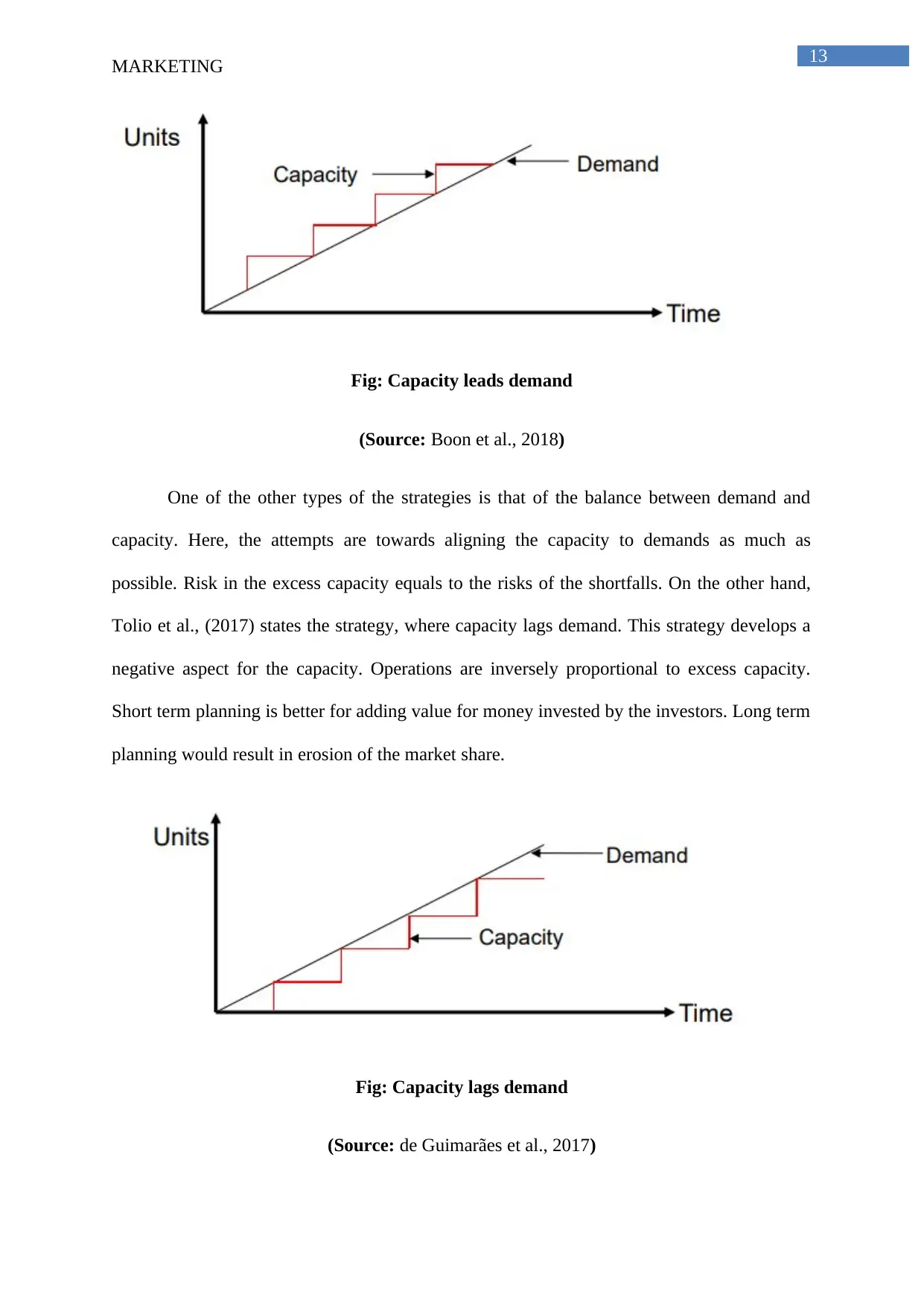
13
MARKETING
Fig: Capacity leads demand
(Source: Boon et al., 2018)
One of the other types of the strategies is that of the balance between demand and
capacity. Here, the attempts are towards aligning the capacity to demands as much as
possible. Risk in the excess capacity equals to the risks of the shortfalls. On the other hand,
Tolio et al., (2017) states the strategy, where capacity lags demand. This strategy develops a
negative aspect for the capacity. Operations are inversely proportional to excess capacity.
Short term planning is better for adding value for money invested by the investors. Long term
planning would result in erosion of the market share.
Fig: Capacity lags demand
(Source: de Guimarães et al., 2017)
MARKETING
Fig: Capacity leads demand
(Source: Boon et al., 2018)
One of the other types of the strategies is that of the balance between demand and
capacity. Here, the attempts are towards aligning the capacity to demands as much as
possible. Risk in the excess capacity equals to the risks of the shortfalls. On the other hand,
Tolio et al., (2017) states the strategy, where capacity lags demand. This strategy develops a
negative aspect for the capacity. Operations are inversely proportional to excess capacity.
Short term planning is better for adding value for money invested by the investors. Long term
planning would result in erosion of the market share.
Fig: Capacity lags demand
(Source: de Guimarães et al., 2017)
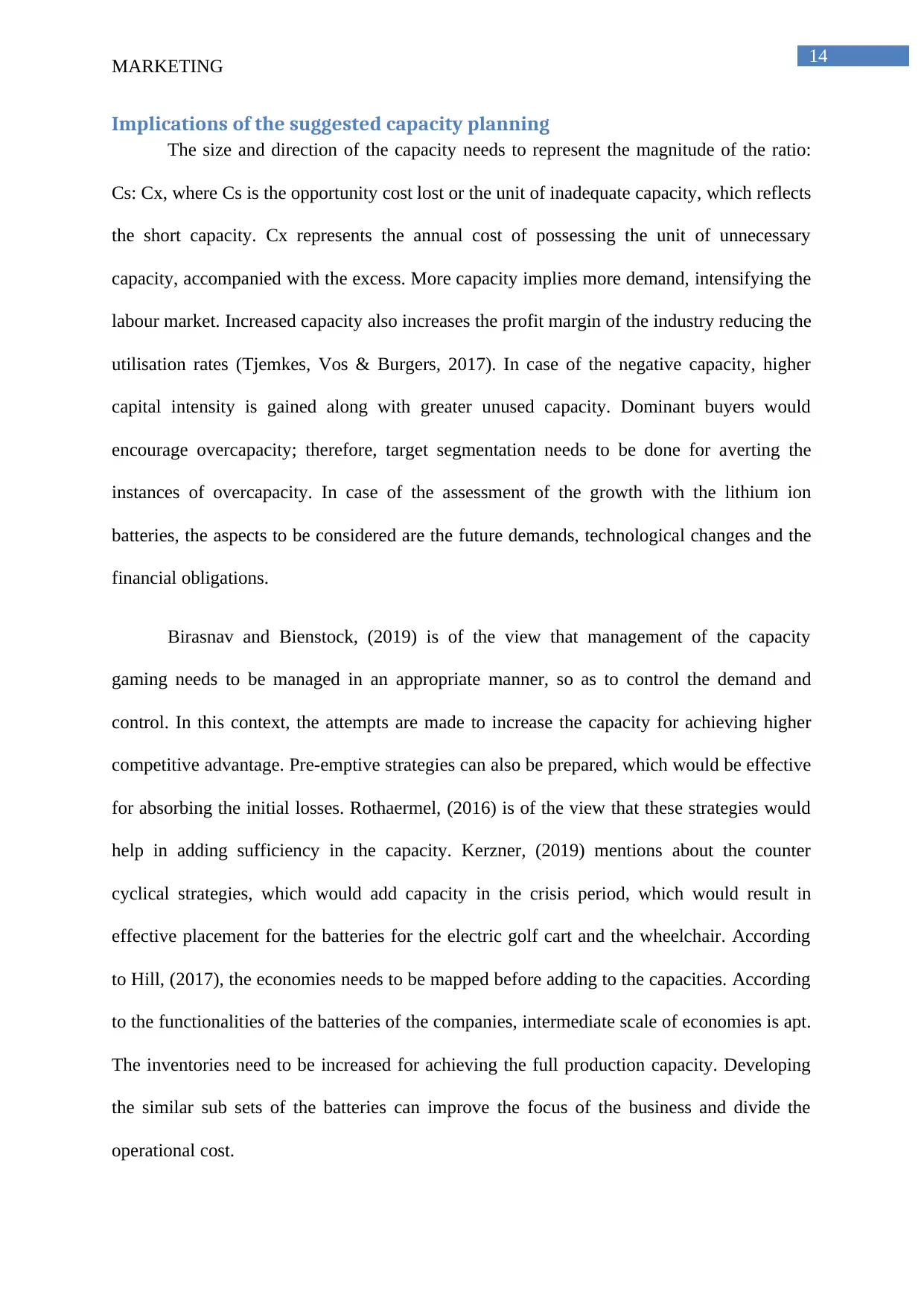
14
MARKETING
Implications of the suggested capacity planning
The size and direction of the capacity needs to represent the magnitude of the ratio:
Cs: Cx, where Cs is the opportunity cost lost or the unit of inadequate capacity, which reflects
the short capacity. Cx represents the annual cost of possessing the unit of unnecessary
capacity, accompanied with the excess. More capacity implies more demand, intensifying the
labour market. Increased capacity also increases the profit margin of the industry reducing the
utilisation rates (Tjemkes, Vos & Burgers, 2017). In case of the negative capacity, higher
capital intensity is gained along with greater unused capacity. Dominant buyers would
encourage overcapacity; therefore, target segmentation needs to be done for averting the
instances of overcapacity. In case of the assessment of the growth with the lithium ion
batteries, the aspects to be considered are the future demands, technological changes and the
financial obligations.
Birasnav and Bienstock, (2019) is of the view that management of the capacity
gaming needs to be managed in an appropriate manner, so as to control the demand and
control. In this context, the attempts are made to increase the capacity for achieving higher
competitive advantage. Pre-emptive strategies can also be prepared, which would be effective
for absorbing the initial losses. Rothaermel, (2016) is of the view that these strategies would
help in adding sufficiency in the capacity. Kerzner, (2019) mentions about the counter
cyclical strategies, which would add capacity in the crisis period, which would result in
effective placement for the batteries for the electric golf cart and the wheelchair. According
to Hill, (2017), the economies needs to be mapped before adding to the capacities. According
to the functionalities of the batteries of the companies, intermediate scale of economies is apt.
The inventories need to be increased for achieving the full production capacity. Developing
the similar sub sets of the batteries can improve the focus of the business and divide the
operational cost.
MARKETING
Implications of the suggested capacity planning
The size and direction of the capacity needs to represent the magnitude of the ratio:
Cs: Cx, where Cs is the opportunity cost lost or the unit of inadequate capacity, which reflects
the short capacity. Cx represents the annual cost of possessing the unit of unnecessary
capacity, accompanied with the excess. More capacity implies more demand, intensifying the
labour market. Increased capacity also increases the profit margin of the industry reducing the
utilisation rates (Tjemkes, Vos & Burgers, 2017). In case of the negative capacity, higher
capital intensity is gained along with greater unused capacity. Dominant buyers would
encourage overcapacity; therefore, target segmentation needs to be done for averting the
instances of overcapacity. In case of the assessment of the growth with the lithium ion
batteries, the aspects to be considered are the future demands, technological changes and the
financial obligations.
Birasnav and Bienstock, (2019) is of the view that management of the capacity
gaming needs to be managed in an appropriate manner, so as to control the demand and
control. In this context, the attempts are made to increase the capacity for achieving higher
competitive advantage. Pre-emptive strategies can also be prepared, which would be effective
for absorbing the initial losses. Rothaermel, (2016) is of the view that these strategies would
help in adding sufficiency in the capacity. Kerzner, (2019) mentions about the counter
cyclical strategies, which would add capacity in the crisis period, which would result in
effective placement for the batteries for the electric golf cart and the wheelchair. According
to Hill, (2017), the economies needs to be mapped before adding to the capacities. According
to the functionalities of the batteries of the companies, intermediate scale of economies is apt.
The inventories need to be increased for achieving the full production capacity. Developing
the similar sub sets of the batteries can improve the focus of the business and divide the
operational cost.
You're viewing a preview
Unlock full access by subscribing today!
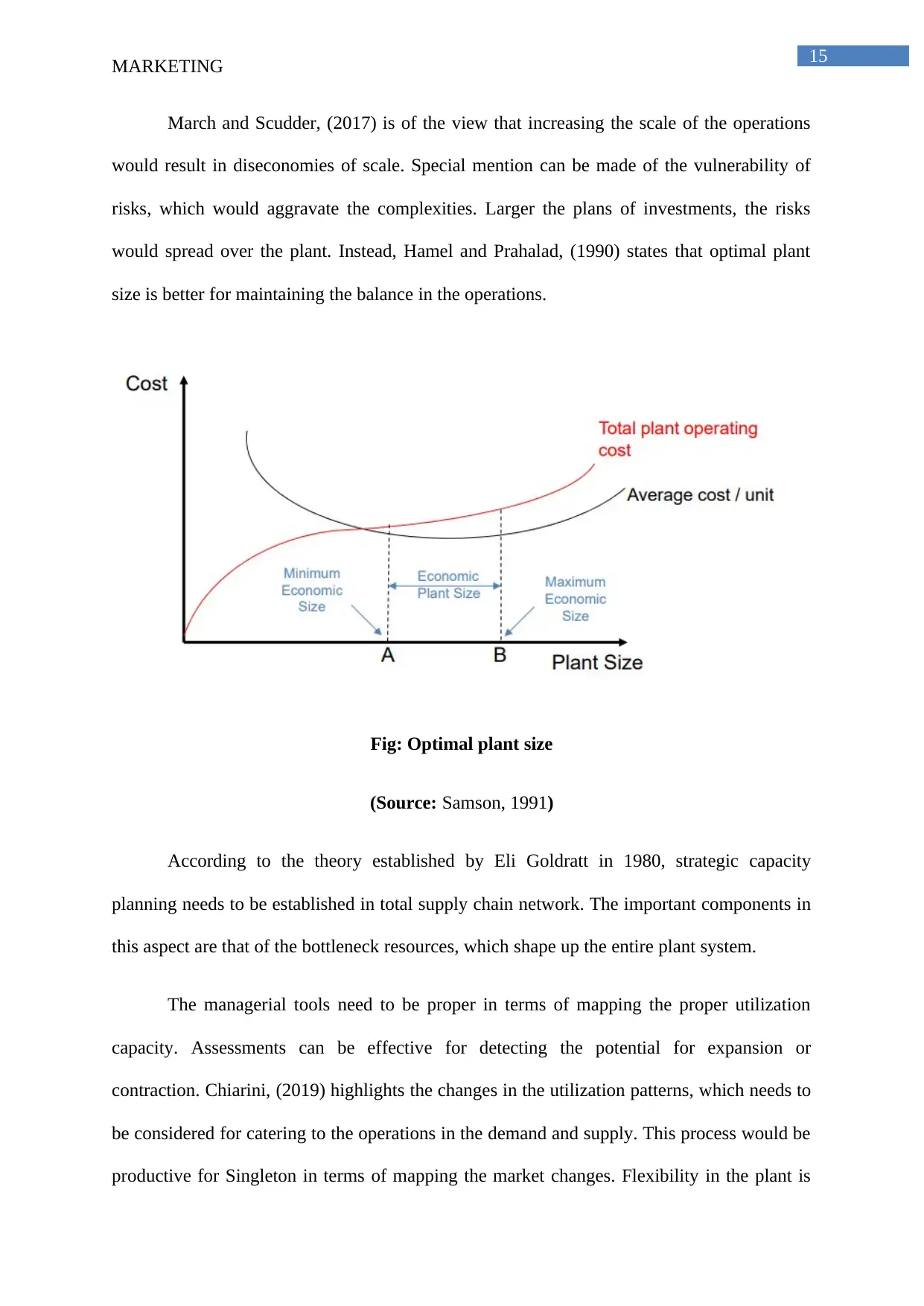
15
MARKETING
March and Scudder, (2017) is of the view that increasing the scale of the operations
would result in diseconomies of scale. Special mention can be made of the vulnerability of
risks, which would aggravate the complexities. Larger the plans of investments, the risks
would spread over the plant. Instead, Hamel and Prahalad, (1990) states that optimal plant
size is better for maintaining the balance in the operations.
Fig: Optimal plant size
(Source: Samson, 1991)
According to the theory established by Eli Goldratt in 1980, strategic capacity
planning needs to be established in total supply chain network. The important components in
this aspect are that of the bottleneck resources, which shape up the entire plant system.
The managerial tools need to be proper in terms of mapping the proper utilization
capacity. Assessments can be effective for detecting the potential for expansion or
contraction. Chiarini, (2019) highlights the changes in the utilization patterns, which needs to
be considered for catering to the operations in the demand and supply. This process would be
productive for Singleton in terms of mapping the market changes. Flexibility in the plant is
MARKETING
March and Scudder, (2017) is of the view that increasing the scale of the operations
would result in diseconomies of scale. Special mention can be made of the vulnerability of
risks, which would aggravate the complexities. Larger the plans of investments, the risks
would spread over the plant. Instead, Hamel and Prahalad, (1990) states that optimal plant
size is better for maintaining the balance in the operations.
Fig: Optimal plant size
(Source: Samson, 1991)
According to the theory established by Eli Goldratt in 1980, strategic capacity
planning needs to be established in total supply chain network. The important components in
this aspect are that of the bottleneck resources, which shape up the entire plant system.
The managerial tools need to be proper in terms of mapping the proper utilization
capacity. Assessments can be effective for detecting the potential for expansion or
contraction. Chiarini, (2019) highlights the changes in the utilization patterns, which needs to
be considered for catering to the operations in the demand and supply. This process would be
productive for Singleton in terms of mapping the market changes. Flexibility in the plant is
Paraphrase This Document
Need a fresh take? Get an instant paraphrase of this document with our AI Paraphraser
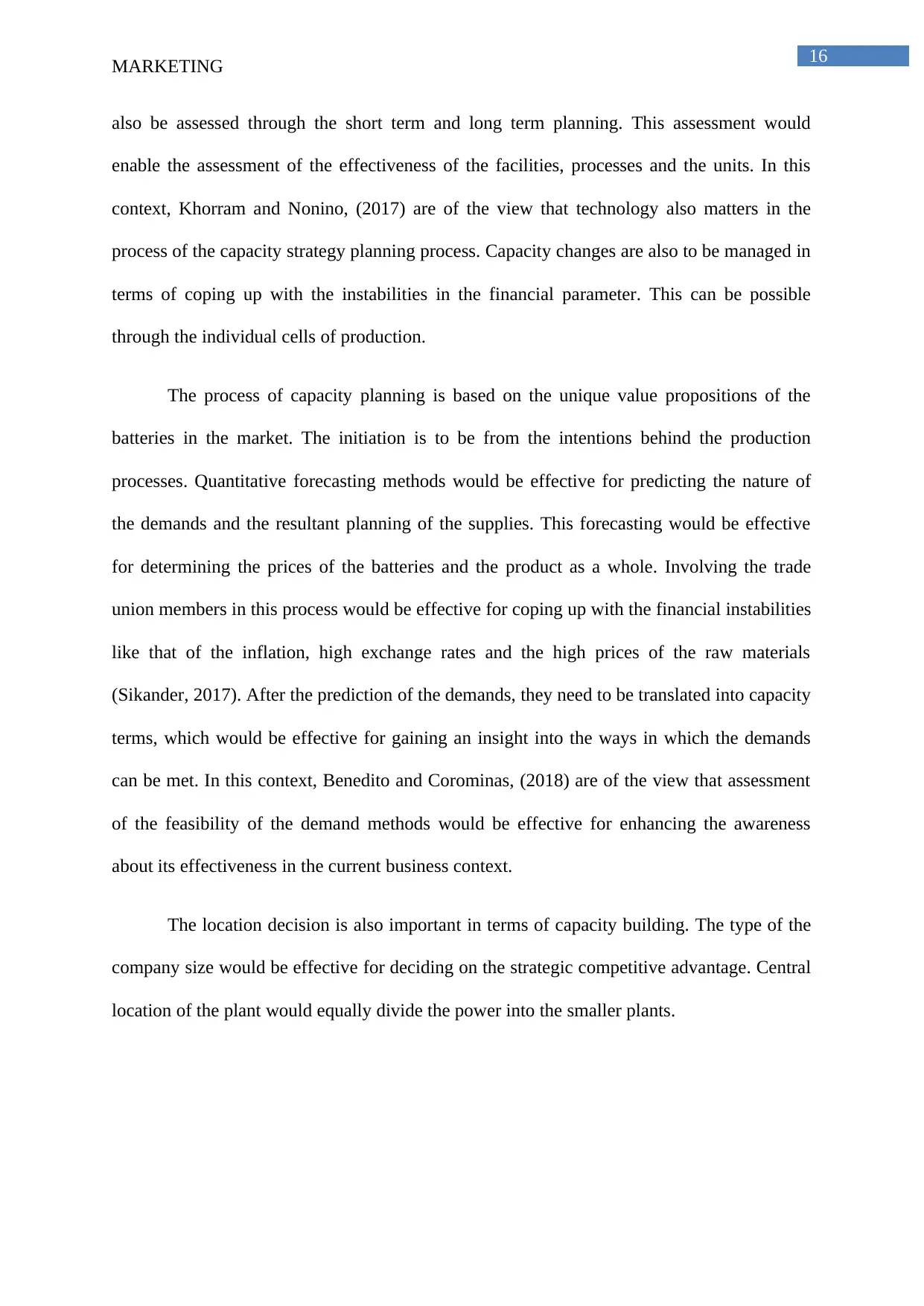
16
MARKETING
also be assessed through the short term and long term planning. This assessment would
enable the assessment of the effectiveness of the facilities, processes and the units. In this
context, Khorram and Nonino, (2017) are of the view that technology also matters in the
process of the capacity strategy planning process. Capacity changes are also to be managed in
terms of coping up with the instabilities in the financial parameter. This can be possible
through the individual cells of production.
The process of capacity planning is based on the unique value propositions of the
batteries in the market. The initiation is to be from the intentions behind the production
processes. Quantitative forecasting methods would be effective for predicting the nature of
the demands and the resultant planning of the supplies. This forecasting would be effective
for determining the prices of the batteries and the product as a whole. Involving the trade
union members in this process would be effective for coping up with the financial instabilities
like that of the inflation, high exchange rates and the high prices of the raw materials
(Sikander, 2017). After the prediction of the demands, they need to be translated into capacity
terms, which would be effective for gaining an insight into the ways in which the demands
can be met. In this context, Benedito and Corominas, (2018) are of the view that assessment
of the feasibility of the demand methods would be effective for enhancing the awareness
about its effectiveness in the current business context.
The location decision is also important in terms of capacity building. The type of the
company size would be effective for deciding on the strategic competitive advantage. Central
location of the plant would equally divide the power into the smaller plants.
MARKETING
also be assessed through the short term and long term planning. This assessment would
enable the assessment of the effectiveness of the facilities, processes and the units. In this
context, Khorram and Nonino, (2017) are of the view that technology also matters in the
process of the capacity strategy planning process. Capacity changes are also to be managed in
terms of coping up with the instabilities in the financial parameter. This can be possible
through the individual cells of production.
The process of capacity planning is based on the unique value propositions of the
batteries in the market. The initiation is to be from the intentions behind the production
processes. Quantitative forecasting methods would be effective for predicting the nature of
the demands and the resultant planning of the supplies. This forecasting would be effective
for determining the prices of the batteries and the product as a whole. Involving the trade
union members in this process would be effective for coping up with the financial instabilities
like that of the inflation, high exchange rates and the high prices of the raw materials
(Sikander, 2017). After the prediction of the demands, they need to be translated into capacity
terms, which would be effective for gaining an insight into the ways in which the demands
can be met. In this context, Benedito and Corominas, (2018) are of the view that assessment
of the feasibility of the demand methods would be effective for enhancing the awareness
about its effectiveness in the current business context.
The location decision is also important in terms of capacity building. The type of the
company size would be effective for deciding on the strategic competitive advantage. Central
location of the plant would equally divide the power into the smaller plants.
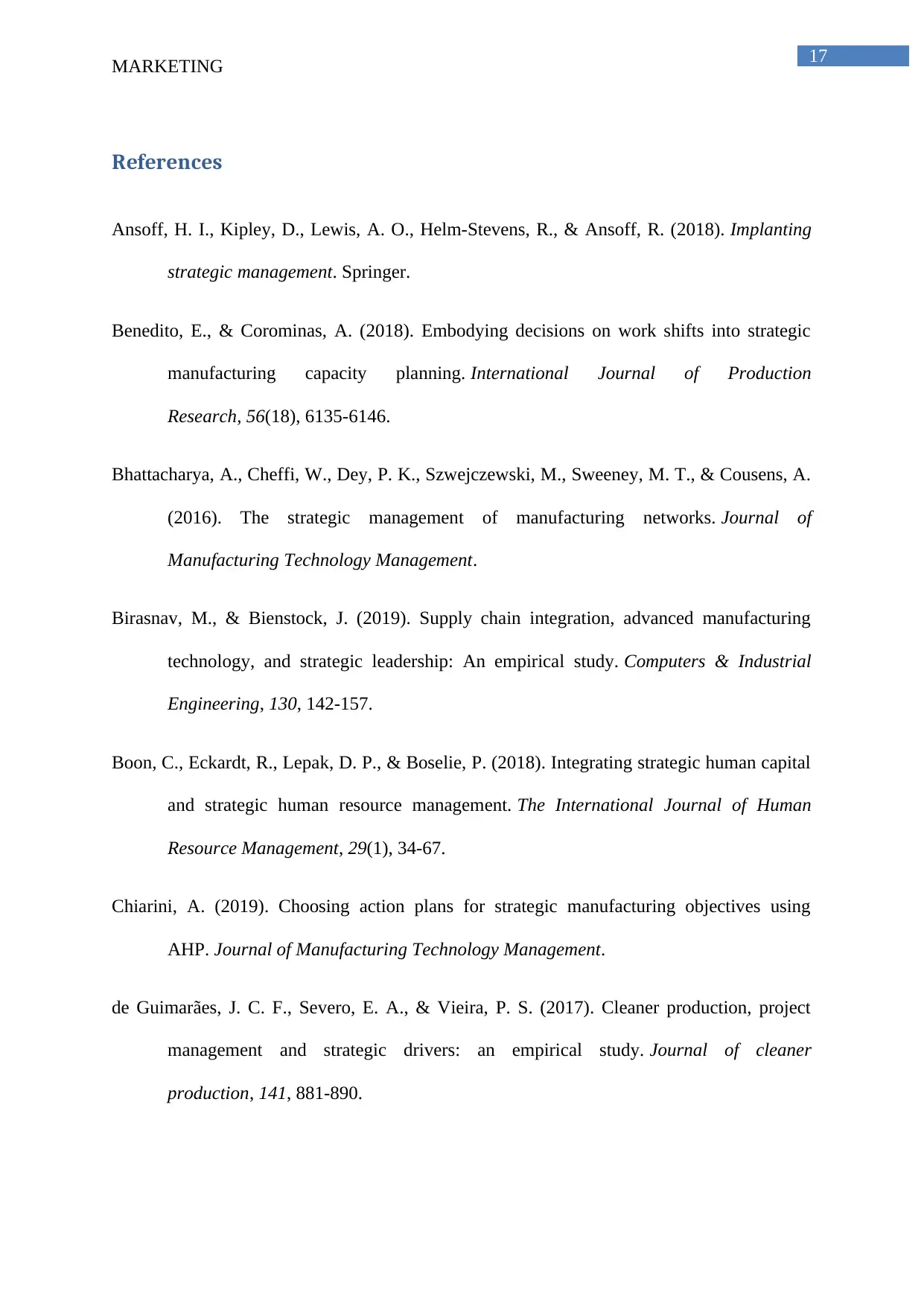
17
MARKETING
References
Ansoff, H. I., Kipley, D., Lewis, A. O., Helm-Stevens, R., & Ansoff, R. (2018). Implanting
strategic management. Springer.
Benedito, E., & Corominas, A. (2018). Embodying decisions on work shifts into strategic
manufacturing capacity planning. International Journal of Production
Research, 56(18), 6135-6146.
Bhattacharya, A., Cheffi, W., Dey, P. K., Szwejczewski, M., Sweeney, M. T., & Cousens, A.
(2016). The strategic management of manufacturing networks. Journal of
Manufacturing Technology Management.
Birasnav, M., & Bienstock, J. (2019). Supply chain integration, advanced manufacturing
technology, and strategic leadership: An empirical study. Computers & Industrial
Engineering, 130, 142-157.
Boon, C., Eckardt, R., Lepak, D. P., & Boselie, P. (2018). Integrating strategic human capital
and strategic human resource management. The International Journal of Human
Resource Management, 29(1), 34-67.
Chiarini, A. (2019). Choosing action plans for strategic manufacturing objectives using
AHP. Journal of Manufacturing Technology Management.
de Guimarães, J. C. F., Severo, E. A., & Vieira, P. S. (2017). Cleaner production, project
management and strategic drivers: an empirical study. Journal of cleaner
production, 141, 881-890.
MARKETING
References
Ansoff, H. I., Kipley, D., Lewis, A. O., Helm-Stevens, R., & Ansoff, R. (2018). Implanting
strategic management. Springer.
Benedito, E., & Corominas, A. (2018). Embodying decisions on work shifts into strategic
manufacturing capacity planning. International Journal of Production
Research, 56(18), 6135-6146.
Bhattacharya, A., Cheffi, W., Dey, P. K., Szwejczewski, M., Sweeney, M. T., & Cousens, A.
(2016). The strategic management of manufacturing networks. Journal of
Manufacturing Technology Management.
Birasnav, M., & Bienstock, J. (2019). Supply chain integration, advanced manufacturing
technology, and strategic leadership: An empirical study. Computers & Industrial
Engineering, 130, 142-157.
Boon, C., Eckardt, R., Lepak, D. P., & Boselie, P. (2018). Integrating strategic human capital
and strategic human resource management. The International Journal of Human
Resource Management, 29(1), 34-67.
Chiarini, A. (2019). Choosing action plans for strategic manufacturing objectives using
AHP. Journal of Manufacturing Technology Management.
de Guimarães, J. C. F., Severo, E. A., & Vieira, P. S. (2017). Cleaner production, project
management and strategic drivers: an empirical study. Journal of cleaner
production, 141, 881-890.
You're viewing a preview
Unlock full access by subscribing today!
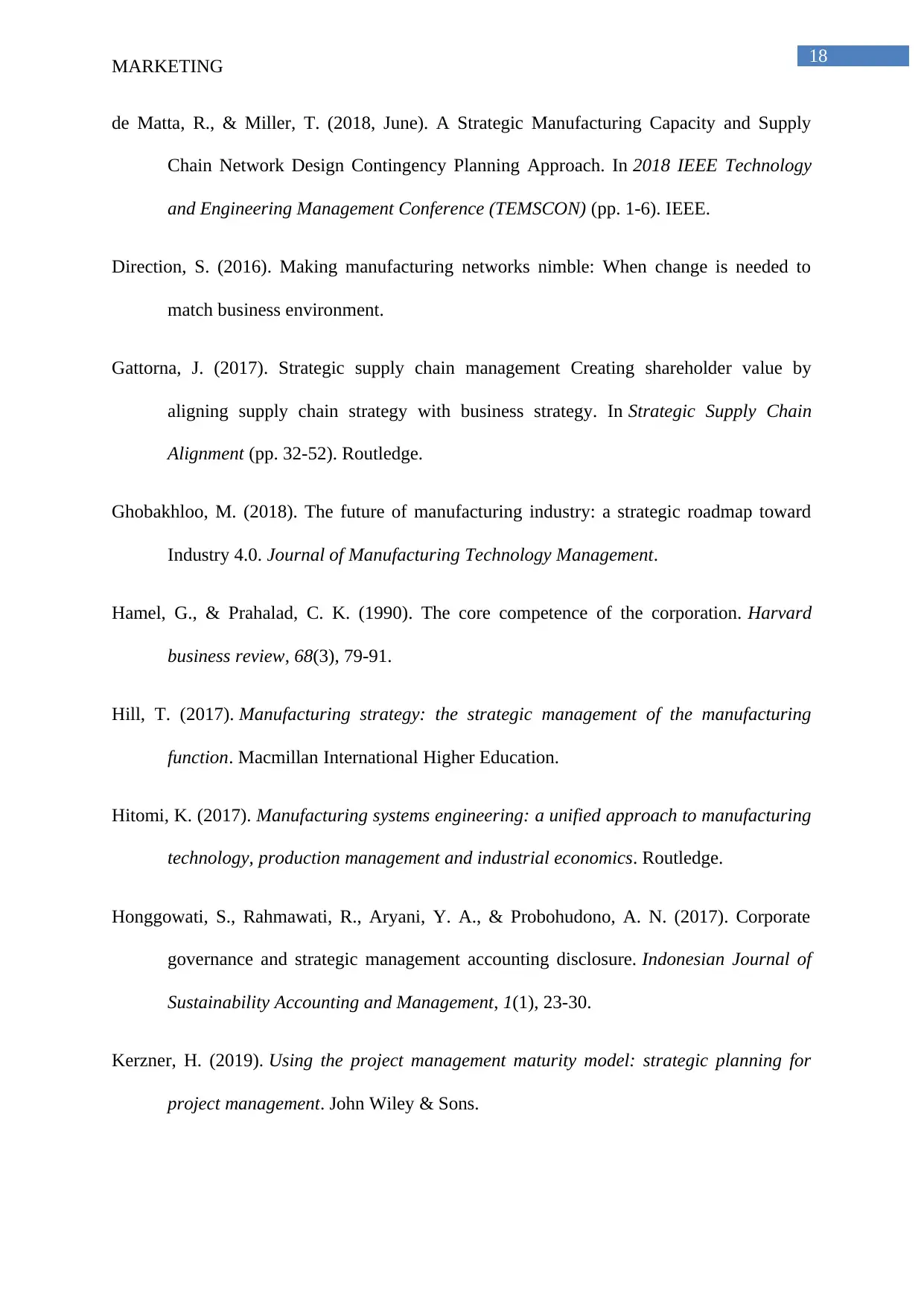
18
MARKETING
de Matta, R., & Miller, T. (2018, June). A Strategic Manufacturing Capacity and Supply
Chain Network Design Contingency Planning Approach. In 2018 IEEE Technology
and Engineering Management Conference (TEMSCON) (pp. 1-6). IEEE.
Direction, S. (2016). Making manufacturing networks nimble: When change is needed to
match business environment.
Gattorna, J. (2017). Strategic supply chain management Creating shareholder value by
aligning supply chain strategy with business strategy. In Strategic Supply Chain
Alignment (pp. 32-52). Routledge.
Ghobakhloo, M. (2018). The future of manufacturing industry: a strategic roadmap toward
Industry 4.0. Journal of Manufacturing Technology Management.
Hamel, G., & Prahalad, C. K. (1990). The core competence of the corporation. Harvard
business review, 68(3), 79-91.
Hill, T. (2017). Manufacturing strategy: the strategic management of the manufacturing
function. Macmillan International Higher Education.
Hitomi, K. (2017). Manufacturing systems engineering: a unified approach to manufacturing
technology, production management and industrial economics. Routledge.
Honggowati, S., Rahmawati, R., Aryani, Y. A., & Probohudono, A. N. (2017). Corporate
governance and strategic management accounting disclosure. Indonesian Journal of
Sustainability Accounting and Management, 1(1), 23-30.
Kerzner, H. (2019). Using the project management maturity model: strategic planning for
project management. John Wiley & Sons.
MARKETING
de Matta, R., & Miller, T. (2018, June). A Strategic Manufacturing Capacity and Supply
Chain Network Design Contingency Planning Approach. In 2018 IEEE Technology
and Engineering Management Conference (TEMSCON) (pp. 1-6). IEEE.
Direction, S. (2016). Making manufacturing networks nimble: When change is needed to
match business environment.
Gattorna, J. (2017). Strategic supply chain management Creating shareholder value by
aligning supply chain strategy with business strategy. In Strategic Supply Chain
Alignment (pp. 32-52). Routledge.
Ghobakhloo, M. (2018). The future of manufacturing industry: a strategic roadmap toward
Industry 4.0. Journal of Manufacturing Technology Management.
Hamel, G., & Prahalad, C. K. (1990). The core competence of the corporation. Harvard
business review, 68(3), 79-91.
Hill, T. (2017). Manufacturing strategy: the strategic management of the manufacturing
function. Macmillan International Higher Education.
Hitomi, K. (2017). Manufacturing systems engineering: a unified approach to manufacturing
technology, production management and industrial economics. Routledge.
Honggowati, S., Rahmawati, R., Aryani, Y. A., & Probohudono, A. N. (2017). Corporate
governance and strategic management accounting disclosure. Indonesian Journal of
Sustainability Accounting and Management, 1(1), 23-30.
Kerzner, H. (2019). Using the project management maturity model: strategic planning for
project management. John Wiley & Sons.
Paraphrase This Document
Need a fresh take? Get an instant paraphrase of this document with our AI Paraphraser
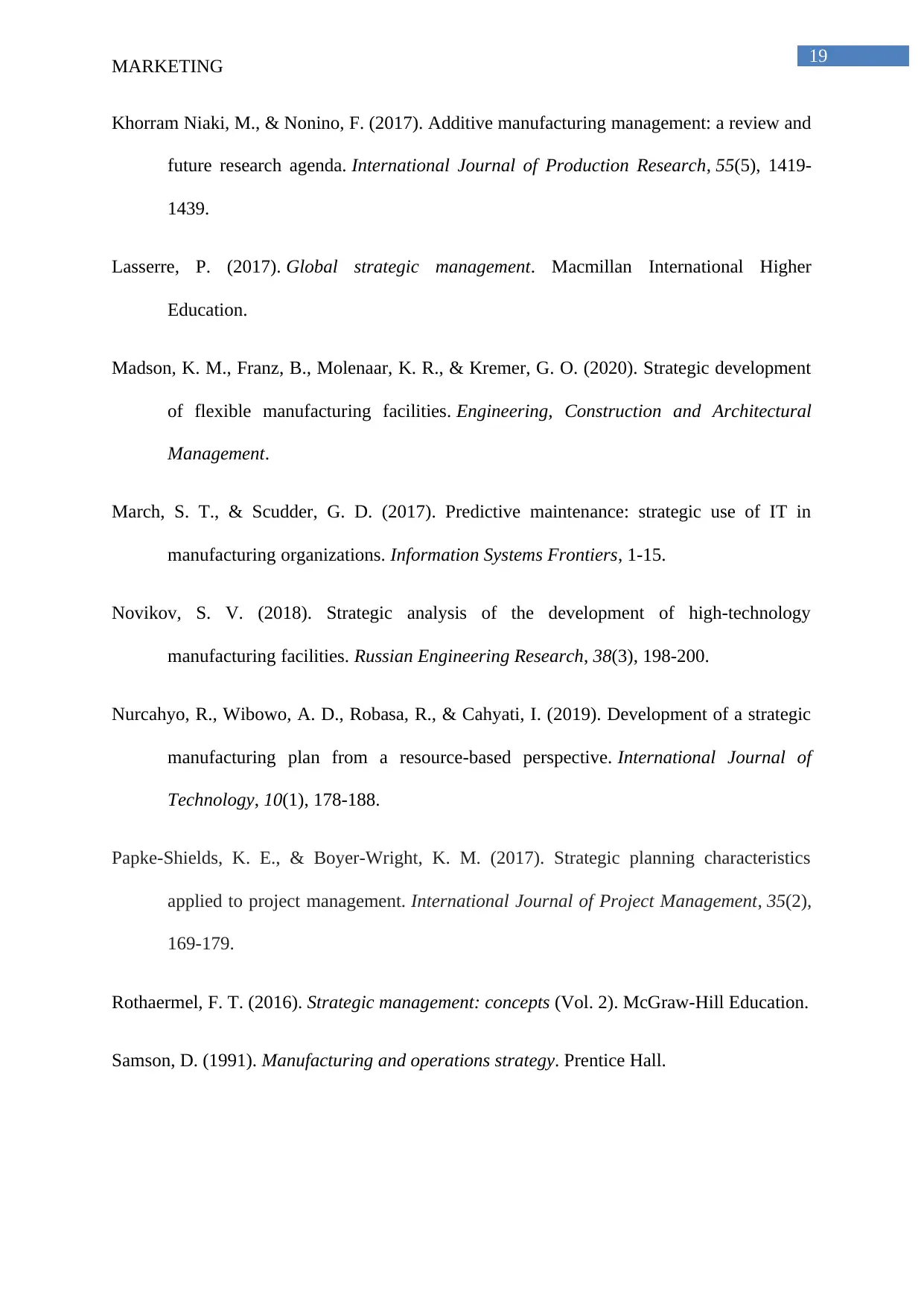
19
MARKETING
Khorram Niaki, M., & Nonino, F. (2017). Additive manufacturing management: a review and
future research agenda. International Journal of Production Research, 55(5), 1419-
1439.
Lasserre, P. (2017). Global strategic management. Macmillan International Higher
Education.
Madson, K. M., Franz, B., Molenaar, K. R., & Kremer, G. O. (2020). Strategic development
of flexible manufacturing facilities. Engineering, Construction and Architectural
Management.
March, S. T., & Scudder, G. D. (2017). Predictive maintenance: strategic use of IT in
manufacturing organizations. Information Systems Frontiers, 1-15.
Novikov, S. V. (2018). Strategic analysis of the development of high-technology
manufacturing facilities. Russian Engineering Research, 38(3), 198-200.
Nurcahyo, R., Wibowo, A. D., Robasa, R., & Cahyati, I. (2019). Development of a strategic
manufacturing plan from a resource-based perspective. International Journal of
Technology, 10(1), 178-188.
Papke-Shields, K. E., & Boyer-Wright, K. M. (2017). Strategic planning characteristics
applied to project management. International Journal of Project Management, 35(2),
169-179.
Rothaermel, F. T. (2016). Strategic management: concepts (Vol. 2). McGraw-Hill Education.
Samson, D. (1991). Manufacturing and operations strategy. Prentice Hall.
MARKETING
Khorram Niaki, M., & Nonino, F. (2017). Additive manufacturing management: a review and
future research agenda. International Journal of Production Research, 55(5), 1419-
1439.
Lasserre, P. (2017). Global strategic management. Macmillan International Higher
Education.
Madson, K. M., Franz, B., Molenaar, K. R., & Kremer, G. O. (2020). Strategic development
of flexible manufacturing facilities. Engineering, Construction and Architectural
Management.
March, S. T., & Scudder, G. D. (2017). Predictive maintenance: strategic use of IT in
manufacturing organizations. Information Systems Frontiers, 1-15.
Novikov, S. V. (2018). Strategic analysis of the development of high-technology
manufacturing facilities. Russian Engineering Research, 38(3), 198-200.
Nurcahyo, R., Wibowo, A. D., Robasa, R., & Cahyati, I. (2019). Development of a strategic
manufacturing plan from a resource-based perspective. International Journal of
Technology, 10(1), 178-188.
Papke-Shields, K. E., & Boyer-Wright, K. M. (2017). Strategic planning characteristics
applied to project management. International Journal of Project Management, 35(2),
169-179.
Rothaermel, F. T. (2016). Strategic management: concepts (Vol. 2). McGraw-Hill Education.
Samson, D. (1991). Manufacturing and operations strategy. Prentice Hall.
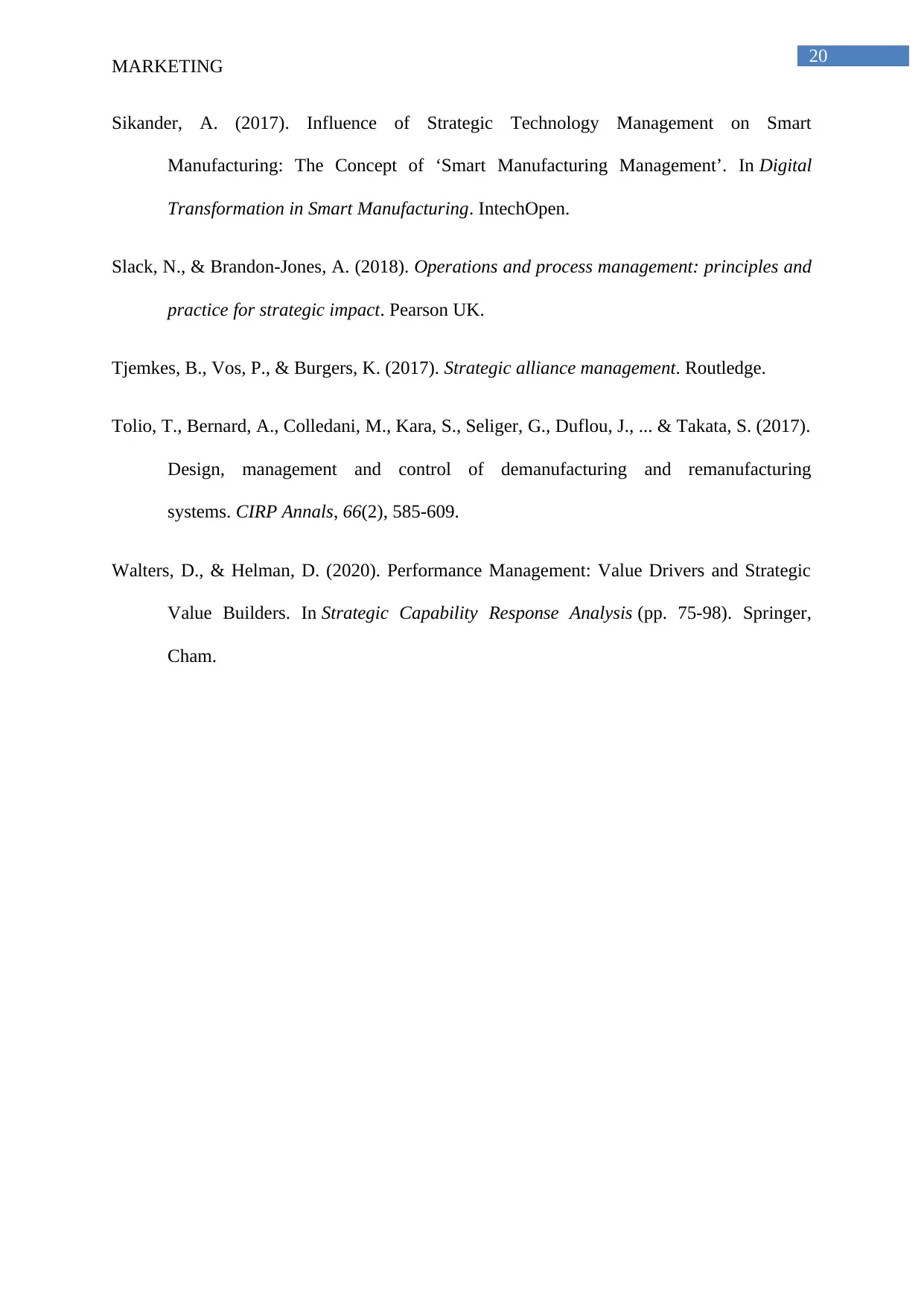
20
MARKETING
Sikander, A. (2017). Influence of Strategic Technology Management on Smart
Manufacturing: The Concept of ‘Smart Manufacturing Management’. In Digital
Transformation in Smart Manufacturing. IntechOpen.
Slack, N., & Brandon-Jones, A. (2018). Operations and process management: principles and
practice for strategic impact. Pearson UK.
Tjemkes, B., Vos, P., & Burgers, K. (2017). Strategic alliance management. Routledge.
Tolio, T., Bernard, A., Colledani, M., Kara, S., Seliger, G., Duflou, J., ... & Takata, S. (2017).
Design, management and control of demanufacturing and remanufacturing
systems. CIRP Annals, 66(2), 585-609.
Walters, D., & Helman, D. (2020). Performance Management: Value Drivers and Strategic
Value Builders. In Strategic Capability Response Analysis (pp. 75-98). Springer,
Cham.
MARKETING
Sikander, A. (2017). Influence of Strategic Technology Management on Smart
Manufacturing: The Concept of ‘Smart Manufacturing Management’. In Digital
Transformation in Smart Manufacturing. IntechOpen.
Slack, N., & Brandon-Jones, A. (2018). Operations and process management: principles and
practice for strategic impact. Pearson UK.
Tjemkes, B., Vos, P., & Burgers, K. (2017). Strategic alliance management. Routledge.
Tolio, T., Bernard, A., Colledani, M., Kara, S., Seliger, G., Duflou, J., ... & Takata, S. (2017).
Design, management and control of demanufacturing and remanufacturing
systems. CIRP Annals, 66(2), 585-609.
Walters, D., & Helman, D. (2020). Performance Management: Value Drivers and Strategic
Value Builders. In Strategic Capability Response Analysis (pp. 75-98). Springer,
Cham.
You're viewing a preview
Unlock full access by subscribing today!
1 out of 21
Related Documents
Your All-in-One AI-Powered Toolkit for Academic Success.
+13062052269
info@desklib.com
Available 24*7 on WhatsApp / Email
![[object Object]](/_next/static/media/star-bottom.7253800d.svg)
Unlock your academic potential
© 2024 | Zucol Services PVT LTD | All rights reserved.




